Table of Contents
- Table Of Contents
- Before Using the Product
- Preparations
- Using "PCoIP"
- Connecting and Using a Source Device
- Screen Setup
- Configuring Tint
- Resizing or Relocating the Screen
- Setup and Reset
- INFORMATION Menu and Others
- Installing the Software
- Troubleshooting Guide
- Specifications
- Appendix
- Index
Samsung LF24FN1PFBZXGO User Manual
Displayed below is the user manual for LF24FN1PFBZXGO by Samsung which is a product in the Computer Monitors category. This manual has pages.
Related Manuals

User manual
NC221
NC221-S
NC221-TS
NC221-TW
NC221W
NC241
NC241-TS
NC241-TW
NC241W
The color and the appearance may differ depending on
the product, and the specifications are subject to
change without prior notice to improve the performance.
BN46-00099F-03

Table Of Contents 2
Table Of Contents
BEFORE USING THE
PRODUCT
7 Copyright
7 Icons used in this manual
8 Cleaning
9 Securing the Installation Space
9 Precautions for storage
10 Safety Precautions
10 Symbols
11 Electricity and Safety
12 Installation and Safety
14 Operation and Safety
17 Correct posture to use the product
PREPARATIONS 18 Checking the Contents
18 Checking the Components
19 Parts
19 Frontal Buttons
21 Reverse Side
22 Installation
22 Attaching the cradle
23 Adjusting the Product Tilt and Height
23 Rotating the Monitor
24 Installing a Wall-mount Kit or Desktop Stand
26 Anti-theft Lock
USING "PCOIP" 27 What is a "PC over IP"?
28 Connection to Use "PCoIP"
28 LAN Connection
28 Connecting USB Devices
29 Connecting a Microphone
29 Connecting to Headphones or Speakers
30 Connecting to a Secondary Monitor
30 Connecting the Power

Table Of Contents
Table Of Contents 3
31 Connect to the host PC using a LAN
cable
32 "PCoIP"
32 On Screen Display (OSD)
32 Connect Screen
33 OSD Options Menu
34 Configuration Window
49 Diagnostics Window
53 Information Window
55 User Settings Window
62 Password Window
64 Wake On LAN
65 Wake on USB
66 OSD Logo Upload
67 Firmwre Update
CONNECTING AND USING
A SOURCE DEVICE
68 Before Connecting
68 Pre-connection Checkpoints
69 Connecting and Using a PC
69 Connecting to a PC
70 "Windows Driver" Installation
71 Setting Optimum Resolution
SCREEN SETUP 72 Brightness
72 Configuring Brightness
73 Contrast
73 Configuring Contrast
74 Sharpness
74 Configuring Sharpness
75 SAMSUNG MAGIC Bright
75 Configuring SAMSUNG MAGIC Bright
76 Coarse
76 Adjusting Coarse

Table Of Contents
Table Of Contents 4
77 Fine
77 Adjusting Fine
CONFIGURING TINT 78 SAMSUNG MAGIC Color
78 Configuring SAMSUNG MAGIC Color
79 Red
79 Configuring Red
80 Green
80 Configuring Green
81 Blue
81 Configuring Blue
82 Color Tone
82 Configuring the Color Tone Settings
83 Gamma
83 Configuring Gamma
RESIZING OR
RELOCATING THE
SCREEN
84 H-Position & V-Position
84 Configuring H-Position & V-Position
85 Menu H-Position & Menu V-Position
85 Configuring Menu H-Position & Menu V-
Position
SETUP AND RESET 86 Reset
86 Initializing Settings (Reset)
87 Language
87 Changing the Language
88 Display Time
88 Configuring Display Time
89 Menu Transparency
89 Changing Menu Transparency

Table Of Contents
Table Of Contents 5
90 Power Key
90 Enabling Power Key
INFORMATION MENU AND
OTHERS
91 INFORMATION
91 Displaying INFORMATION
91 Configuring Volume in the Initial Screen
INSTALLING THE
SOFTWARE
92 Natural Color
92 What is Natural Color?
93 MultiScreen
93 Installing the Software
94 Removing the Software
TROUBLESHOOTING
GUIDE
95 Requirements Before Contacting
Samsung Customer Service Center
95 Testing the Product
95 Checking the Resolution and Frequency
95 Check the following.
98 Q & A
SPECIFICATIONS 100 General
102 Standard Signal Mode Table
APPENDIX 104 Contact SAMSUNG WORLD WIDE
110 Responsibility for the Pay Service (Cost
to Customers)
110 Not a product defect
110 A Product damage caused by customer's fault
110 Others
111 Correct Disposal
111 Correct Disposal of This Product (Waste
Electrical & Electronic Equipment)
111 Correct disposal of batteries in this product

7
Before Using the Product
Before Using the Product
Copyright
The contents of this manual are subject to change without notice to improve quality.
© 2015 Samsung Electronics
Samsung Electronics owns the copyright for this manual.
Use or reproduction of this manual in parts or entirety without the authorization of Samsung Electronics is
prohibited.
Microsoft and Windows are registered trademarks of Microsoft Corporation.
VESA, DPM and DDC are registered trademarks of the Video Electronics Standards Association.
Icons used in this manual
An administration fee may be charged if either
(a) an engineer is called out at your request and there is no defect in the product
(i.e. where you have failed to read this user manual).
(b) you bring the unit to a repair centre and there is no defect in the product
(i.e. where you have failed to read this user manual).
The amount of such administration charge will be advised to you before any work or home visit is
carried out.
The following images are for reference only. Real-life situations may
differ from what is shown in the images.

8
Before Using the Product
Before Using the Product
Cleaning
Exercise care when cleaning as the panel and exterior of advanced LCDs are easily scratched.
Take the following steps when cleaning.
1. Power off the monitor and computer.
2. Disconnect the power cord from the monitor.
Hold the power cable by the plug and do not touch the cable with wet
hands. Otherwise, an electric shock may result.
3. Wipe the monitor screen using a clean, soft and dry cloth.
Do not apply a cleaning agent that contains alcohol,
solvent, or surfactant to the monitor.
Do not spray water or detergent directly on the product.
4. Wet a soft and dry cloth in water and wring thoroughly to clean the
exterior of the monitor.
5. Connect the power cord to the product after cleaning the product.
6. Power on the monitor and computer.
!
!

9
Before Using the Product
Before Using the Product
Securing the Installation Space
Ensure some space around the product for ventilation. An internal temperature rise may cause fire
and damage the product. Be sure to allow the amount of space as shown below or greater when
installing the product.
The exterior may differ depending on the product.
Precautions for storage
Be sure to contact Samsung Customer Service Center (page 104) if the inside of the monitor needs
cleaning. (Service fee will be charged.)
10 cm (3.9 Inches)
10 cm (3.9 Inches)
10 cm (3.9 Inches)
10 cm
(3.9 Inches)
10 cm
(3.9 Inches)

10
Before Using the Product
Before Using the Product
Safety Precautions
Symbols
Caution
RISK OF ELECTRIC SHOCK DO NOT OPEN
Caution: TO REDUCE THE RISK OF ELECTRIC SHOCK, DO NOT REMOVE COVER (OR
BACK). THERE ARE NO USER SERVICEABLE PARTS INSIDE. REFER ALL SERVICING TO
QUALIFIED PERSONNEL.
This symbol indicates that high voltage is present inside. It is dangerous to
make any kind of contact with any internal part of this product.
This symbol alerts you that important literature concerning operation and
maintenance has been included with this product.
Warning A serious or fatal injury may result if instructions are not followed.
Caution
Personal injury or damage to properties may result if instructions are
not followed.
Activities marked by this symbol are prohibited.
Instructions marked by this symbol must be followed.
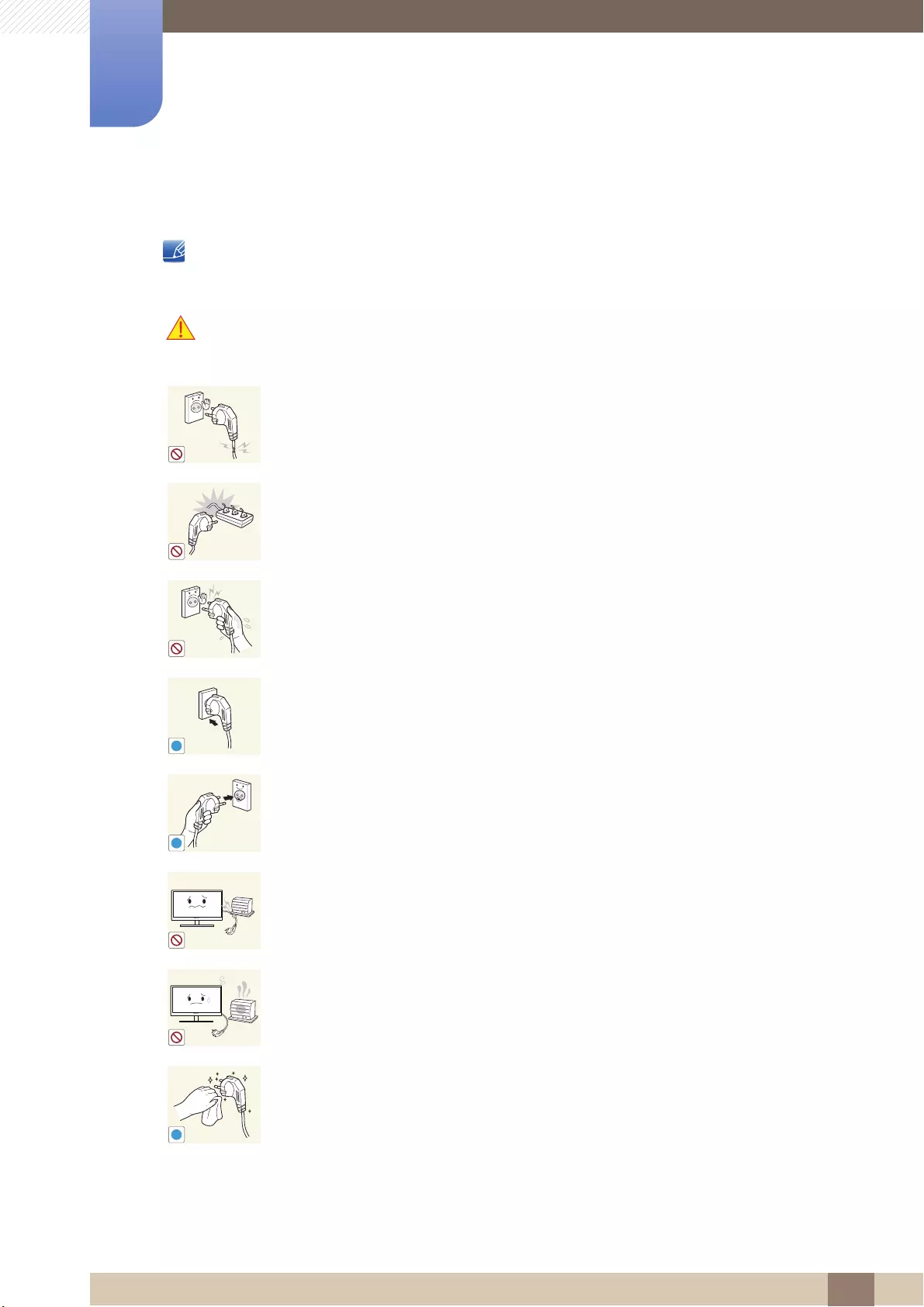
11
Before Using the Product
Before Using the Product
Electricity and Safety
The following images are for reference only. Real-life situations may differ from what is shown in the
images.
Warning
Do not use a damaged power cord or plug, or a loose power socket.
An electric shock or fire may result.
Do not plug many products into the same power socket.
Otherwise, the socket may overheat and cause a fire.
Do not touch the power plug with wet hands.
Otherwise, an electric shock may result.
Insert the power plug all the way in so it is not loose.
An unstable connection may cause a fire.
Ensure you connect the power plug to a grounded power socket. (type 1
insulated devices only).
An electric shock or injury may result.
Do not bend or pull the power cord with force. Do not weigh the power cord
down with a heavy object.
A damaged power cord may cause an electric shock or fire.
Do not place the power cord or product near heat sources.
An electric shock or fire may result.
Remove foreign substances such as dust around the plug pins and power socket
with a dry cloth.
Otherwise, a fire may result.
!
!
!

12
Before Using the Product
Before Using the Product
Caution
Installation and Safety
Warning
Do not unplug the power cord when the product is in use.
The product may become damaged by an electric shock.
Do not use the power cord for products other than authorized products supplied
by Samsung.
An electric shock or fire may result.
Keep the power socket where the power cord is connected unobstructed.
If any problem occurs in the product, unplug the power cable to completely
cut the power to the product.
Power to the product cannot be completely cut off with the power button.
Hold the plug when disconnecting the power cord from the power socket.
An electric shock or fire may result.
DO NOT PLACE CANDLES, INSECT REPELLANTS OR CIGARETTES ON TOP
OF THE PRODUCT. DO NOT INSTALL THE PRODUCT NEAR HEAT SOURCES.
Otherwise, a fire may result.
Avoid installing the product in a narrow space with bad ventilation, such as a
bookshelf or wall closet.
Otherwise, a fire may result due to an increased internal temperature.
Keep the plastic packaging bag for the product in a place that cannot be reached
by children.
Children may suffocate.
!
!
!
!

13
Before Using the Product
Before Using the Product
Caution
Do not install the product on an unstable or vibrating surface (insecure shelf,
sloped surface, etc.).
The product may fall and break or cause a personal injury.
Using the product in an area with excess vibration may damage the product
or cause a fire.
Do not install the product in a vehicle or a place exposed to dust, moisture (water
drips, etc.), oil, or smoke.
An electric shock or fire may result.
Do not expose the product to direct sunlight, heat, or a hot object such as a
stove.
Otherwise, the product lifespan may be reduced, or a fire may result.
Do not install the product within the reach of young children.
The product may fall and injure children.
Edible oil, such as soybean oil, can damage or deform the product. Do not install
the product in a kitchen or near a kitchen counter.
Take care not to drop the product when moving it.
Otherwise, product failure or personal injury may result.
Do not set down the product on its front.
The screen may become damaged.
When installing the product on a cabinet or shelf, make sure that the bottom
edge of the front of the product is not protruding.
The product may fall and break or cause a personal injury.
Install the product only on cabinets or shelves of the right size.
!
!

14
Before Using the Product
Before Using the Product
Operation and Safety
Warning
Put down the product carefully.
The product may fall and break or cause a personal injury.
Installing the product in an unusual place (a place exposed to a lot of fine dust,
chemical substances, extreme temperatures or a significant presence of
moisture, or a place where the product will operate continuously for an extended
period of time) may seriously affect its performance.
Be sure to consult Samsung Customer Service Center (page 104) before
installation if you want to install the product at such a place.
High voltage runs through the product. Do not attempt to disassemble, repair, or
modify the product on your own.
An electric shock or fire may result.
Contact Samsung Customer Service Center (page 104) for repair.
Before moving the product, turn off the power switch and disconnect the power
cable and all other connected cables.
Otherwise, the power cord may be damaged and a fire or electric shock may
result.
If the product generates a strange noise, a burning smell, or smoke, remove the
power cord immediately and contact Samsung Customer Service Center (page
104).
An electric shock or fire may result.
Do not let children hang from the product or climb on top of it.
The product may fall, and your child may become injured or seriously
harmed.
If the product falls or the exterior is damaged, power off the product, remove the
power cord, and contact Samsung Customer Service Center (page 104).
Otherwise, an electric shock or fire may result.
Do not put a heavy object, toy, or sweets on top of the product.
The product or heavy objects may fall as children try to reach for the toy or
sweets resulting in a serious injury.
!
SAMSUNG
!
!
!

15
Before Using the Product
Before Using the Product
If there is a thunderstorm or lightning strike, turn off the power and disconnect the
power cable.
An electric shock or fire may result.
Do not drop objects on the product or apply impact.
An electric shock or fire may result.
Do not move the product by pulling the power cord or any cable.
Otherwise, the cable may be damaged and product failure, an electric shock
or fire may result.
If a gas leakage is found, do not touch the product or power plug. Also, ventilate
the area immediately.
Sparks can cause an explosion or fire.
Do not lift or move the product by pulling the power cord or any cable.
Otherwise, the cable may be damaged and product failure, an electric shock
or fire may result.
Do not use or keep combustible spray or an inflammable substance near the
product.
An explosion or fire may result.
Ensure the vents are not blocked by tablecloths or curtains.
Otherwise, a fire may result from an increased internal temperature.
Do not insert a metallic object (a chopstick, coin, hair pin, etc.) or inflammable
object (paper, match, etc.) into the vent or ports of the product.
If water or any foreign substance enters the product, be sure to power off the
product, remove the power cord, and contact Samsung Customer Service
Center (page 104).
Product failure, an electric shock or fire may result.
Do not place objects containing liquid (vases, pots, bottles, etc) or metallic
objects on top of the product.
If water or any foreign substance enters the product, be sure to power off the
product, remove the power cord, and contact Samsung Customer Service
Center (page 104).
Product failure, an electric shock or fire may result.
!
!
!
GAS
!
10 0

16
Before Using the Product
Before Using the Product
Caution
Leaving the screen fixed on a stationary image for an extended period of time
may cause afterimage burn-in or defective pixels.
If you are not going to use the product for an extended period of time,
activate power-saving mode or a moving-picture screen saver.
Disconnect the power cord from the power socket if you do not plan on using the
product for an extended period of time (vacation, etc.).
Otherwise, a fire may result from accumulated dust, overheating, an electric
shock, or electric leakage.
Use the product at the recommended resolution and frequency.
Your eyesight may deteriorate.
Looking at the screen too close for an extended period of time can deteriorate
your eyesight.
Do not hold the monitor upside-down or move it by holding the stand.
The product may fall and break or cause a personal injury.
Do not use humidifiers or stoves around the product.
An electric shock or fire may result.
Rest your eyes for more than 5 minutes for every 1 hour of product use.
Eye fatigue will be relieved.
Do not touch the screen when the product has been turned on for an extended
period of time as it will become hot.
Store the small accessories used with the product out of reach of children.
!
!
-_-
!
!
!
!
!

17
Before Using the Product
Before Using the Product
Correct posture to use the product
Exercise caution when adjusting the product angle or stand height.
Otherwise, children's fingers or hands may become stuck and injured.
Tilting the product excessively may cause it to fall and result in personal
injury.
Do not place heavy objects on the product.
Product failure or personal injure may result.
Do not increase the volume too high when using headphones (earphones).
Sound particularly at a higher volume could potentially affect long-term
hearing.
!
Use the product in the correct posture as follows:
Straighten your back.
Allow a distance of 45 to 50cm between your eye and the screen, and look slightly
downward at the screen.
Keep your eyes directly in front of the screen.
Adjust the angle so light does not reflect on the screen.
Keep your forearms perpendicular to your upper arms and level with the back of
your hands.
Keep your elbows at about a right angle.
Adjust the height of the product so you can keep your knees bent at 90 degrees or
more, your heels attached to the floor, and your arms lower than your heart.

18
1 Preparations
1 Preparations
1.1 Checking the Contents
1.1.1 Checking the Components
Contact the dealer from whom you purchased the product if any item is missing.
The appearance of the components may differ from the images shown.
Components
Components may vary depending on the country.
Quick Setup Guide Warranty card
(Not available in some locations) Regulatory guide
User manual Power cable Stand base

19
Preparations
1
1 Preparations
1.2 Parts
1.2.1 Frontal Buttons
The color and shape of parts may differ from what is shown. Specifications are subject to change
without notice to improve quality.
Icons Description
Open or close the onscreen display (OSD) menu, or return to the
parent menu.
OSD control lock: Maintain the current settings, or lock the OSD
control to prevent unintended changes to settings.
Enable: To lock the OSD control, press the MENU button [ ] for
five seconds.
Disable: To unlock the locked OSD control, press the MENU button
[ ] for more than five seconds.
Connect to a server.
Move to the upper or lower menu or adjust the value for an option on the
OSD menu.
Adjust the Volume.
When the OSD guide is displayed, the [ ] button activates the function
assigned to Volume.
SOURCE
AUTO
SOURCE
AUTO
OSD Guide
MENU
M
ENU
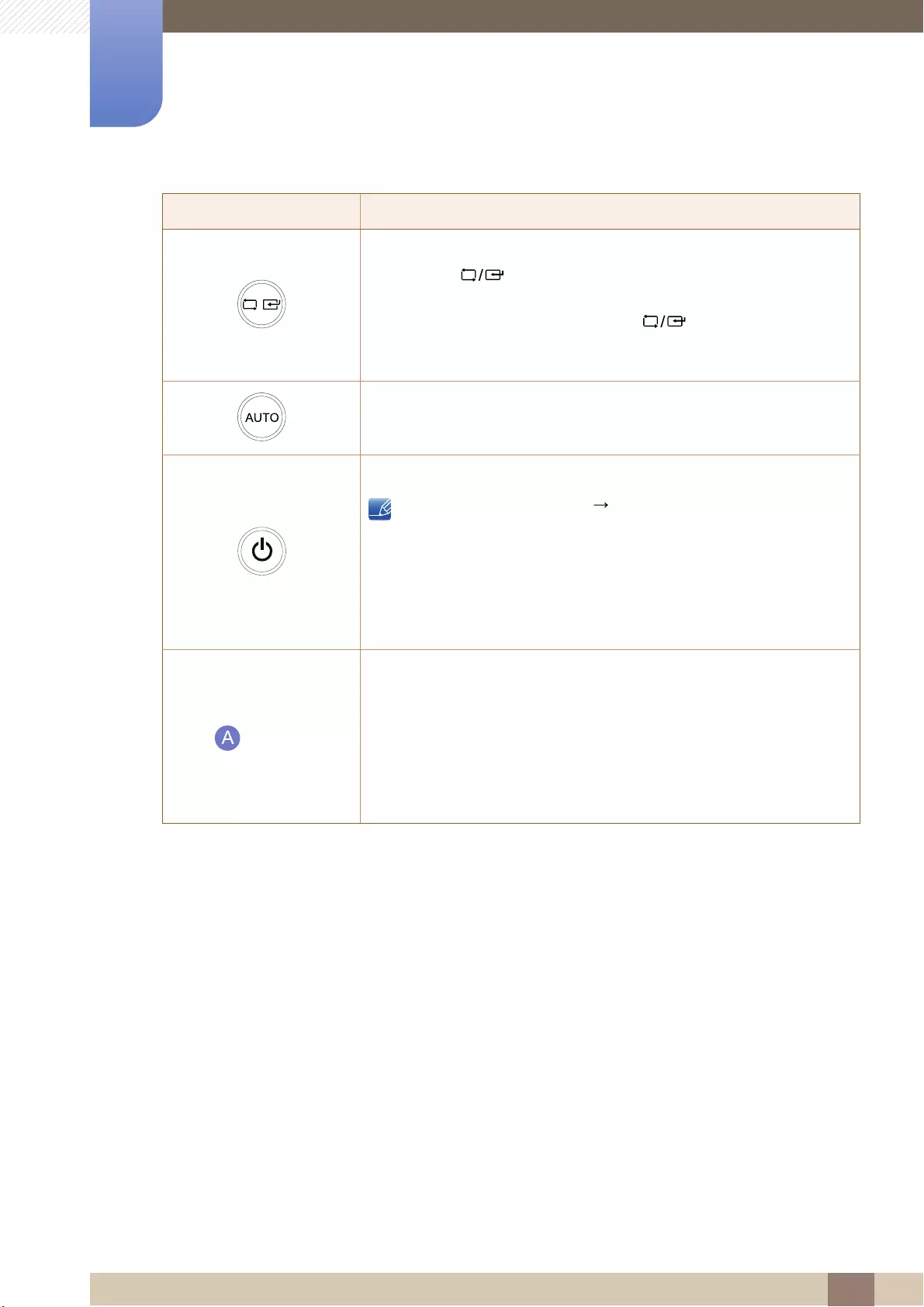
20
Preparations
1
1 Preparations
Confirm a menu selection.
Pressing the [ ] button when the OSD menu is not displayed will
change the input source (Client/Analog). If you power on the product or
change the input source by pressing the [ ] button, a message that
shows the changed input source will appear at the top left corner of the
screen.
Analog mode: Automatically adjust the screen settings.
Client mode: Disconnect from the server.
Power on or off the product.
Go to SETUP&RESET Power Key and select Power Off or
Screen Off. (Refer to "7.5 Power Key" for details on
Power Key).
To turn the product on or off when Power Off is selected, press
the power button.
The default setting is Power Off.
OSD Guide
When a control button on the product is pressed, the OSD guide will be
displayed before the onscreen menu opens. (The guide shows the
function of the button pressed.)
To access the onscreen menu when the guide is displayed, press the
corresponding button again.
The OSD guide may vary depending on the function or product model.
Refer to the actual product.
Icons Description

21
Preparations
1
1 Preparations
1.2.2 Reverse Side
The color and shape of parts may differ from what is shown. Specifications are subject to change
without notice to improve quality.
Port Description
Connect to an audio output device such as headphones.
Connect to a microphone.
Connect to an audio-input source using an audio cable.
Connect to a USB device.
Connect to a PC using the D-SUB cable.
Connect to a secondary monitor using the DVI cable.
Connect to a network using the LAN cable.
Connect to the power cable.
RGB IN MIC
AUDIO IN
ON
POWER IN LANDVI OUT
MIC
AUDIO IN
RGB IN
DVI OUT
LAN
ON
POWER IN

22
Preparations
1
1 Preparations
1.3 Installation
1.3.1 Attaching the cradle
Disassembly is the reverse order of assembly.
The color and shape of parts may differ from what is shown. Specifications are subject to change
without notice to improve quality.
Place a protective cloth or
cushion on a flat surface. Next,
place the product with the face
down on top of the cloth or
cushion.
Insert the stand base into the
stand in the direction of the
arrow.
Do not remove the fixing pin until
you are finished attaching the
stand.
Fasten the screw tightly (using a
screwdriver or coin) into the
bottom of the base.
After installing the stand, place
the product upright.
You can remove the fixing pin
and adjust the stand now.
- Caution
Do not hold the product upside
down only by the stand.

23
Preparations
1
1 Preparations
1.3.2 Adjusting the Product Tilt and Height
The color and shape of parts may differ from what is shown. Specifications are subject to change
without notice to improve quality.
To adjust the height, remove the fixing pin.
The monitor tilt and height can be adjusted.
Hold the top center of the product and adjust the height carefully.
1.3.3 Rotating the Monitor
You can rotate your monitor as shown below.
Be sure to fully extend the stand before rotating the monitor.
If you rotate the monitor without fully extending the stand, the corner of the monitor may hit the
floor and get damaged.
Do not rotate the monitor counterclockwise. The monitor may get damaged.

24
Preparations
1
1 Preparations
1.3.4 Installing a Wall-mount Kit or Desktop Stand
Before Installation
Power the product off and remove the power cable from the power socket.
Align the grooves and tightly fasten the screws on the bracket on the product with the corresponding
parts on the wall-mount kit or desktop stand you want to attach.
Place a protective cloth or
cushion on a flat surface. Next,
place the product with the face
down on top of the cloth or
cushion.
Unfasten the screw from the
back of the product.
Lift and detach the stand.
Installing a Wall-mount Kit or Desktop Stand
Attach the wall-mount kit or desktop stand here
Bracket (sold separately)
1
A
2
B
34
A
B

25
Preparations
1
1 Preparations
Notes
Using a screw longer than the standard length can damage the internal components of the
product.
The length of screws required for a wall mount that does not comply with the VESA standards may
vary depending on the specifications.
Do not use screws that do not comply with the VESA standards. Do not attach the wall-mount kit
or desktop stand using excessive force. The product may get damaged or fall and cause personal
injury. Samsung shall not be held liable for any damage or injury caused by using improper screws
or attaching the wall-mount kit or desktop stand using excessive force.
Samsung shall not be held liable for any product damage or personal injury caused by using a wall-
mount kit other than the one specified or from an attempt to install the wall-mount kit on your own.
To mount the product on a wall, ensure you purchase a wall-mount kit that can be installed 10cm
or farther away from the wall.
Be sure to use a wall-mount kit that complies with the standards.
To install the monitor using a wall mount, disconnect the stand base from the monitor.

26
Preparations
1
1 Preparations
1.3.5 Anti-theft Lock
An anti-theft lock allows you to use the product securely even in public places. The locking device shape
and locking method depend on the manufacturer. Refer to the user guide provided with your anti-theft
locking device for details. The lock device is sold separately.
To lock an anti-theft locking device:
1Fix the cable of your anti-theft locking device to a heavy object such as a desk.
2Put one end of the cable through the loop on the other end.
3Insert the locking device into the anti-theft lock slot at the back of the product.
4Lock the locking device.
An anti-theft locking device can be purchased separately.
Refer to the user guide provided with your anti-theft locking device for details.
Anti-theft locking devices can be purchased at electronics retailers or online.

27
2 Using "PCoIP"
2 Using "PCoIP"
2.1 What is a "PC over IP"?
This monitor can decode and display the screen of the server PC encoded and transmitted through
the network (LAN) as well as display the computer screen like a conventional monitor. This monitor
shows a far more improved performance than a normal RDP and has been designed to support a
resolution of 1920*1080 pixels for high-quality graphic work.
This monitor enables reinforced security because it is used by connecting it to a server PC and
enabling you to access the Internet, create documents and edit figures. In addition, this new-
concept monitor enables you to play music, videos and games by connecting an external input
source device such as DSC, MP3, external storage device etc. to the USB port.
This monitor can be utilized for various fields such as video conferencing and co-working by
displaying the network display screen on another display device by connecting the device through
the DVI OUT port.

28
Using "PCoIP"
2
2 Using "PCoIP"
2.2 Connection to Use "PCoIP"
Do not connect the power cable before connecting all other cables.
Ensure you connect a source device first before connecting the power cable.
2.2.1 LAN Connection
1Connect the LAN cable to [LAN] on the back of the product.
It is not supported when the network speed is below or equal to 10Mbps.
Use Cat7(*STP Type) cable for the connection.
*STP: Shielded Twist Pair
2.2.2 Connecting USB Devices
The [ ] port supports up to USB 2.0.
VMware View 4.6 or later is required. Data transfer rate may decrease depending on the network
conditions.
1Connect a USB device, such as a keyboard or mouse, to [ ] at the back of the product.
LAN

29
Using "PCoIP"
2
2 Using "PCoIP"
2.2.3 Connecting a Microphone
1Connect a microphone to the [MIC] jack at the back of the product.
2.2.4 Connecting to Headphones or Speakers
1Connect an audio output device, such as headphones or speakers, to [ ] at the back of the
product.
MIC

30
Using "PCoIP"
2
2 Using "PCoIP"
2.2.5 Connecting to a Secondary Monitor
1Connect [DVI OUT] on the product to [DVI IN] or [RGB IN] on another monitor using a DVI or DVI to
D-SUB cable.
The [DVI OUT] port can be used only to connect to a dual monitor.
Connect to the [DVI OUT] port to display the same picture on another monitor such as the
projector. (For presentation purposes)
The maximum resolution is 1920 x 1200 when a dual monitor is connected.
2.2.6 Connecting the Power
1Connect the power cable to the product and the power outlet, then turn on the power switch.
(The input voltage is switched automatically).
DVI OUT DVI IN
RGB IN
DVI OUT
POWER IN

31
Using "PCoIP"
2
2 Using "PCoIP"
2.3 Connect to the host PC using a LAN cable
The host PC must have an IP address.
After connecting the LAN and setting the IP address, you can view the host PC screen on the monitor.
Use the USB port to connect an external storage device (DSC, MP3, external storage, etc.).
Connecting one Host PC to many client device is possible only when virtualization solution like vmware
is installed in Host PC.
Host PC Hub LAN Cable Monitor
Connect the power cord to the power terminal at the back of the monitor.
Connect the mouse and the keyboard to the USB ports.
Connect the LAN port on the back of the monitor and the hub.
Connect the hub and the LAN port of the host PC.
1
2
3
4
1
2
3
4

32
Using "PCoIP"
2
2 Using "PCoIP"
2.4 "PCoIP"
2.4.1 On Screen Display (OSD)
The On Screen Display (OSD) local GUI is displayed to the user when the device is powered on and a
PCoIP session is not in progress. The OSD lets the user connect to a host device through the Connect
window.
The Connect window allows access to the Options page which provides some of the functions provided
by the Administrative Web Interface.
To access the Options page, click the Options menu on the Connect window.
2.4.2 Connect Screen
The Connect window will appear during startup except when the client is configured for a managed
startup or auto-reconnect.
You can change the logo that appears above the Connect button by uploading a replacement image
through the Administrative Web Interface Upload menu.
Connect Button
Click the Connect button to start a PCoIP session. When the PCoIP connection is pending, the OSD
local GUI displays a "Connection Pending" message. When the connection is established, the OSD local
GUI will disappear and the session image will appear.
Figure 2-1: OSD Connect Screen (Connecting)

33
Using "PCoIP"
2
2 Using "PCoIP"
2.4.3 OSD Options Menu
Selecting the Options menu will display a list of selections. The OSD Options menu contains:
Configuration
This option lets you configure various settings for the device such as network settings, session type,
language, and other settings.
Diagnostics
This option helps you troubleshoot the device.
Information
This option lets you view certain details about the device.
User Settings
This option lets the user define certificate checking mode, Mouse, Keyboard, Display Topology,
as well as the PCoIP protocol image quality.
Password
This option lets you update the administrative password for the device.
For firmware versions 4.6.0 and later, the default password is set to blank.
Clicking the Unlock button then pressing the Enter key will unlock the product.
Selecting an option will display a settings window.
Figure 2-2: OSD Options Menu

34
Using "PCoIP"
2
2 Using "PCoIP"
2.4.4 Configuration Window
The Configuration option on the Administrative Web Interface and OSD lets you configure various
settings for the device.
The tabs in the Configuration window are:
Each tab has the following buttons: OK, Cancel, and Apply.
These buttons allow the administrator to accept or cancel the changes made.
The OSD configuration options are a subset of the options available in the Administrative Web
Interface.
Visit the Teradici Support Site: http://techsupport.teradici.com for further details on the
SCEP, Label, Access and tabs.
For optimal performance, install the Teradici Audio Driver on your VM and select it as the default
playback device.
For further details, visit the Teradici Support Site at http://techsupport.teradici.com and log in.
Go to Download Center Teradici Virtual Audio Driver.
Network IPv6 SCEP
Label Discovery Session
Language Power Display
Access Audio Reset
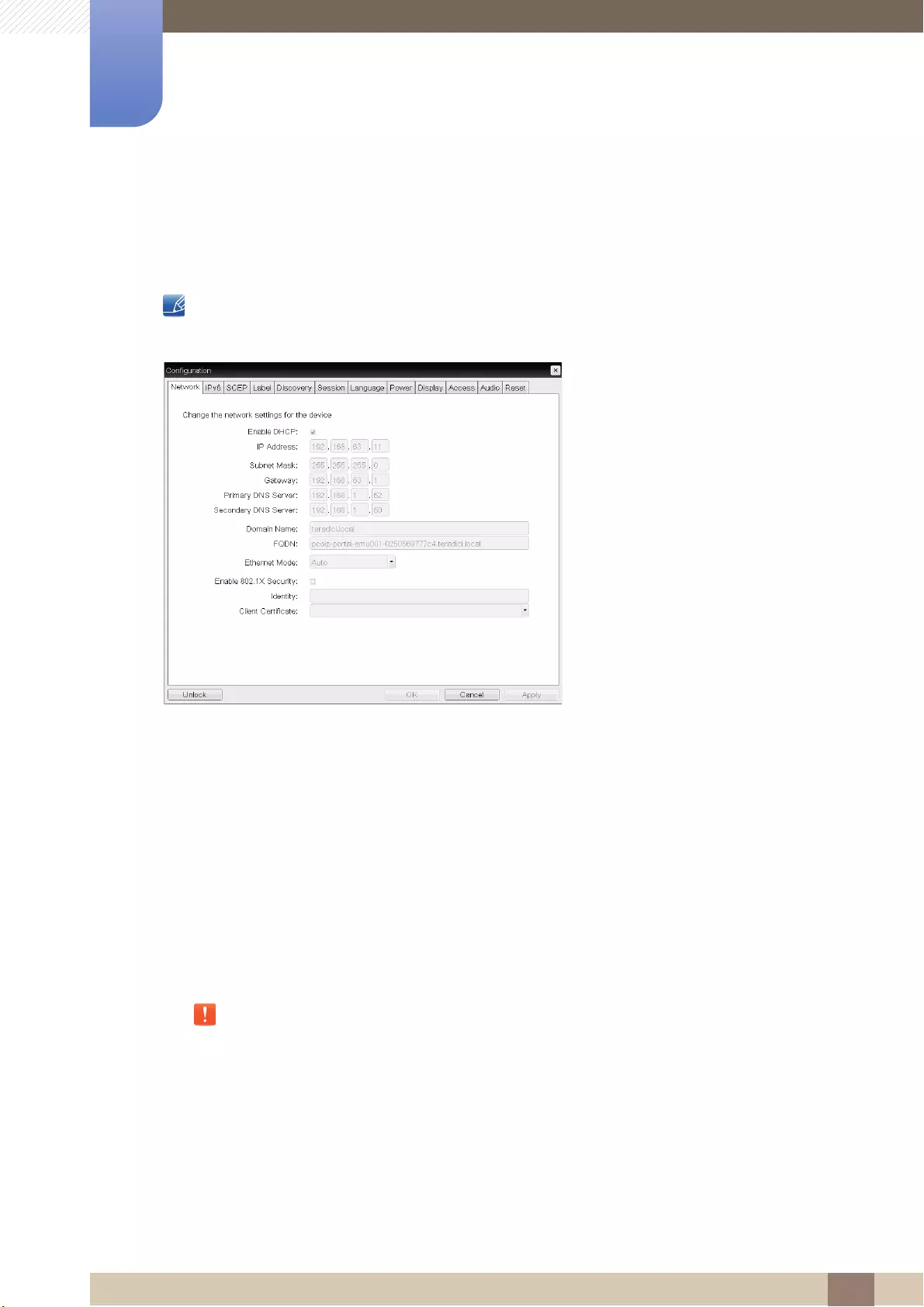
35
Using "PCoIP"
2
2 Using "PCoIP"
Network Tab
You can configure the host and client network settings from the Initial Setup page or Network page.
After you update the parameters on this page, click Apply to save your changes.
The Network parameters can also be configured using the Administrative Web Interface.
Figure 2-3: Network Configuration
Enable DHCP
When Enable DHCP is enabled, the device will contact a DHCP server to be assigned an IP
address, subnet mask, gateway IP address and DNS servers. When disabled, the device requires
these parameters to be set manually.
IP Address
The IP address of the device. If DHCP is disabled, you must set this field to a valid IP address.
If DHCP is enabled, you cannot edit this field.
Subnet Mask
The subnet mask of the device. If DHCP is disabled, you must set this field to a valid subnet mask.
If DHCP is enabled, you cannot edit this field.
It is possible to configure an illegal IP address/subnet mask combination (e.g., invalid mask)
making the device unreachable. Ensure you set the subnet mask properly.
Gateway
The gateway IP address of the device. If DHCP is disabled, this field is required. If DHCP is enabled,
you cannot edit this field.
Primary DNS Server
The primary DNS IP address of the device. This field is optional. If the DNS server IP address is
configured using the Connection Manager, the address may be set as an FQDN instead of an IP
address.

36
Using "PCoIP"
2
2 Using "PCoIP"
Secondary DNS Server
The secondary DNS IP address of the device. This field is optional.
If the DNS server IP address is configured using the Connection Manager, the address may be set
as an FQDN instead of an IP address.
Domain Name
The domain name used (e.g., 'domain.local'). This field is optional.
This field specifies the host or domain of the client.
FQDN
The Fully Qualified Domain Name for the host or client. The default value is pcoip-host-<MAC> or
pcoipportal-<MAC> where <MAC> is the MAC address of the host or client.
The domain name is appended if used (e.g., pcoip-host-<MAC>.domain.local).
This field is read-only on this page.
Ethernet Mode
Lets you configure the Ethernet mode of the host or client as:
Auto
100 Mbps Full-Duplex
10 Mbps Full-Duplex
When you choose 10 Mbps Full-Duplex or 100 Mbps Full-Duplex and then click Apply, a warning
message will appear.
"Warning: When Auto-Negotiation is disabled on the PCoIP device, it must also be disabled on the
switch. Additionally, the PCoIP device and switch must be configured to use the same speed and
duplex parameters. Different parameters may result in a loss of network connectivity.
Are you sure you want to continue?" Click OK to change the parameter.
You should always set the Ethernet Mode to Auto and only use 10 Mbps Full-Duplex or
100 Mbps Full-duplex when the other network equipment (i.e., switch) is also configured to
operate at 10 Mbps Full-Duplex or 100 Mbps Full-duplex. An improperly configured Ethernet
Mode may result in the network operating at half-duplex which is not supported by the PCoIP
protocol. The session will be severely degraded and eventually dropped.
Enable 802.1X Security: If the connected network supports 802.1x, Enable 802.1X Security
should be enabled and security-authenticated devices can only be used.
If Enable 802.1X Security is enabled, configure the Authentication, Identity and Client Certificate
settings.
TLS (Transport Layer Security) is only supported as an authentication protocol at present.
Identity: Enter the product ID that will be used on the network.
Client Certificate: Select a certificate uploaded from the Certificate Upload page.

37
Using "PCoIP"
2
2 Using "PCoIP"
IPv6 Tab
The IPv6 page lets you enable IPv6 for PCoIP devices connected to your IPv6 network.
When you make a change to one of the settings on this page, you must reboot your device for the
change to take effect.
Figure 2-4: IPv6 Configuration
Enable IPv6
Enable this field to enable IPv6 for your PCoIP devices.
Link Local Address
This field is automatically populated.
Gateway
Enter the gateway address.
Enable DHCPv6
Enable this field to set up Dynamic Host Configuration Protocol version 6 (DHCPv6) for your device.
Primary DNS
The primary DNS IP address of the device. If DHCPv6 is enabled, this field is automatically populated
by the DHCPv6 server.
Secondary DNS
The secondary DNS IP address of the device. If DHCPv6 is enabled, this field is automatically
populated by the DHCPv6 server.
Domain Name
The domain name used (e.g., 'domain.local') for the host or client. If DHCPv6 is enabled, this field is
automatically populated by the DHCPv6 server.

38
Using "PCoIP"
2
2 Using "PCoIP"
FQDN
The fully qualified domain name for the host or client. If DHCPv6 is enabled, this field is automatically
populated by the DHCPv6 server.
Enable SLAAC
Enable this field to set up stateless address auto-configuration (SLAAC) for your devices.
Enable Manual Address
Enable this field to set up a manual (static) address for the device.
Manual Address
Enter the IP address for the device.

39
Using "PCoIP"
2
2 Using "PCoIP"
Label Tab
The Label page is available from the host or client. The Label page lets you add information for the
device.
The Portal Label parameters can also be configured using the Administrative Web Interface.
Figure 2-5: Label Configuration
PCoIP Device Name
If the PCoIP Device Name allows the administrator to give the Host or Portal a logical name.
The default value is pcoip-host-MAC or pcoip-portal-MAC where MAC is the MAC address of the
Host or Portal.
PCoIP Device Description
A description and additional information such as the location of the endpoint for the device.
The firmware does not use this field. It is provided for administrator use only.
Generic Tag
Generic tag information about the device. The firmware does not use this field.
It is provided for administrator use only.

40
Using "PCoIP"
2
2 Using "PCoIP"
Discovery Tab
Use the settings on the Discovery page to erase the discovery of hosts and clients in your PCoIP system
and dramatically reduce the configuration and maintenance effort for complex systems. This discovery
mechanism is independent of DNS SRV discovery.
For SLP discovery to work, routers must be configured to forward multicast traffic between subnets.
DNS-SRV Discovery is the recommended discovery mechanism because most deployments do not
allow this.
Figure 2-6: Discovery Configuration
Enable Discovery
If the Enable Discovery option is enabled, the device will dynamically discover peer devices using
SLP Discovery without requiring prior information on their locations in the network.
This can dramatically reduce configuration and maintenance effort for complex systems.
SLP discovery requires routers configured to allow multicast. DNS-SRV Discovery is the
recommended method.

41
Using "PCoIP"
2
2 Using "PCoIP"
Session Tab
The Session page lets you configure how the host or client device connects to or accepts connections
from peer devices.
The Session parameters can also be configured using the Administrative Web Interface.
Figure 2-7: Session Configuration
Connection Type
Select Direct to Host from the Session page to display the following setting items:
Direct to Host: Connect to a PC or Work Station that has a Host Card installed.
DNS Name or IP Address: Enter the DNS Name or IP Address of the server to connect to.

42
Using "PCoIP"
2
2 Using "PCoIP"
Figure 2-8: Connection Type Configuration
When you select a View Connection Server type from the Session page, specific configuration
options will appear.
View Connection Server: Connect to the VMware VDI (Virtual Desktop Infrastructure)
server. VMware VDI is a virtual desktop solution.
DNS Name or IP Address: Enter the VMware View Connection Server's
DNS Name or IP Address.
Figure 2-9: Connection Type Configuration
Advanced
Visit the Teradici Support Site: http://techsupport.teradici.com for further details.

43
Using "PCoIP"
2
2 Using "PCoIP"
Language Tab
The Language page lets you change the user interface language.
This setting affects the local OSD GUI. It is only available on the client.
The Language parameters can also be configured using the Administrative Web Interface.
Figure 2-10: Language Configuration
Language
Configure the OSD language. This setting determines the language for OSD only.
It does not affect the language setting for the actual user session.
Supported languages: English, French, German, Greek, Spanish, Italian, Portuguese, Korean,
Japanese, Traditional Chinese, Simplified Chinese
Keyboard Layout
Change the layout of the keyboard. When the user starts a session, this setting is controlled through
the virtual machine. If the Windows Group Policy Object (GPO) is set to allow the keyboard layout
setting, the setting is applied during the session of the user. If the Windows GPO is not set to allow
the setting, the setting is not applied.

44
Using "PCoIP"
2
2 Using "PCoIP"
Power Tab
Figure 2-11: Power Configuration
OSD Screen-Saver Timeout (when not connected to a session): Connected monitors will go into
standby mode if left idle for a specified period of time (in seconds).
Enter "0" if you do not want to use the standby mode function.
Display Suspend Timeout (when connected to a session): Connected monitors will go into standby
mode if left idle for a specified period of time (in seconds).
Enter "0" if you do not want to use the standby mode function.

45
Using "PCoIP"
2
2 Using "PCoIP"
Display Tab
The Display page lets you enable the Extended Display Identification Data(EDID) override mode.
This function is only available through the OSD.
Under normal operation, the GPU in the host computer queries a monitor attached to the zero client to
determine the monitor's capabilities. In some situations, a monitor may be connected to a client in a way
that prevents the client from reading the EDID information, such as when connecting through certain
KVM devices.
The options in this page configure the client to advertise default EDID information to the GPU.
Enabling display override forces the default monitor display information to be used which may not be
compatible with the connected monitor resulting in a blank monitor. Only enable display override when
there is no valid EDID information and monitor display characteristics are known.
Figure 2-12: Display Configuration
Enable Attached Display Override
This option is intended for legacy systems. It configures the client to send default EDID information
to the host when a monitor cannot be detected or is not attached to the client. In versions of
Windows prior to Windows 7, once the host had no EDID information, it would assume no monitors
were attached and would never recheck. This option ensures that the host always has EDID
information when the client is in session.
The following default resolutions are advertised when this option is enabled:
800 x 600 @ 60 Hz
1024 x 768 @ 60 Hz (native resolution advertised)
1280 x 800 @ 60 Hz
1280 x 960 @ 60 Hz

46
Using "PCoIP"
2
2 Using "PCoIP"
1280 x 1024 @ 60 Hz
1600 x 1200 @ 60 Hz
1680 x 1050 @ 60 Hz
1920 x 1080 @ 60 Hz
1920 x 1200 @ 60 Hz
If Enable Attached Display Override is activated, all displays connected to the client are set to the
default resolution of 1024 x 768.
Enable Display Cloning
This feature allows you to display the same screen on two monitors simultaneously while in dual
monitor mode.

47
Using "PCoIP"
2
2 Using "PCoIP"
Audio Tab
Configure the audio settings (e.g., mic and headphones).
Figure 2-13: Audio Configuration
Enable Local USB Audio Driver
Sound will play from the internal speakers when playing music found on the server.e internal speakers.
Sound output and connected devices
Connected devices Enable Local USB
Audio Driver Device Type Sound output
USB headphones + earphones Select ( ) USB
USB headphones
USB headphones + earphones Select ( ) Analog earphone
Earphones only Deselect ( ) -earphone
-Deselect ( ) -
Internal speakers

48
Using "PCoIP"
2
2 Using "PCoIP"
Reset Tab
The Reset page lets you reset configuration and permissions to factory default values stored in onboard
flash memory.
Reset can also be initiated using the Administrative Web Interface.
Resetting parameters to factory default values does not revert the firmware or clear the custom
OSD logo.
Figure 2-14: Reset Configuration
Reset Parameters
When you click this button, a message will appear prompting you for confirmation.
This prevents an accidental reset.
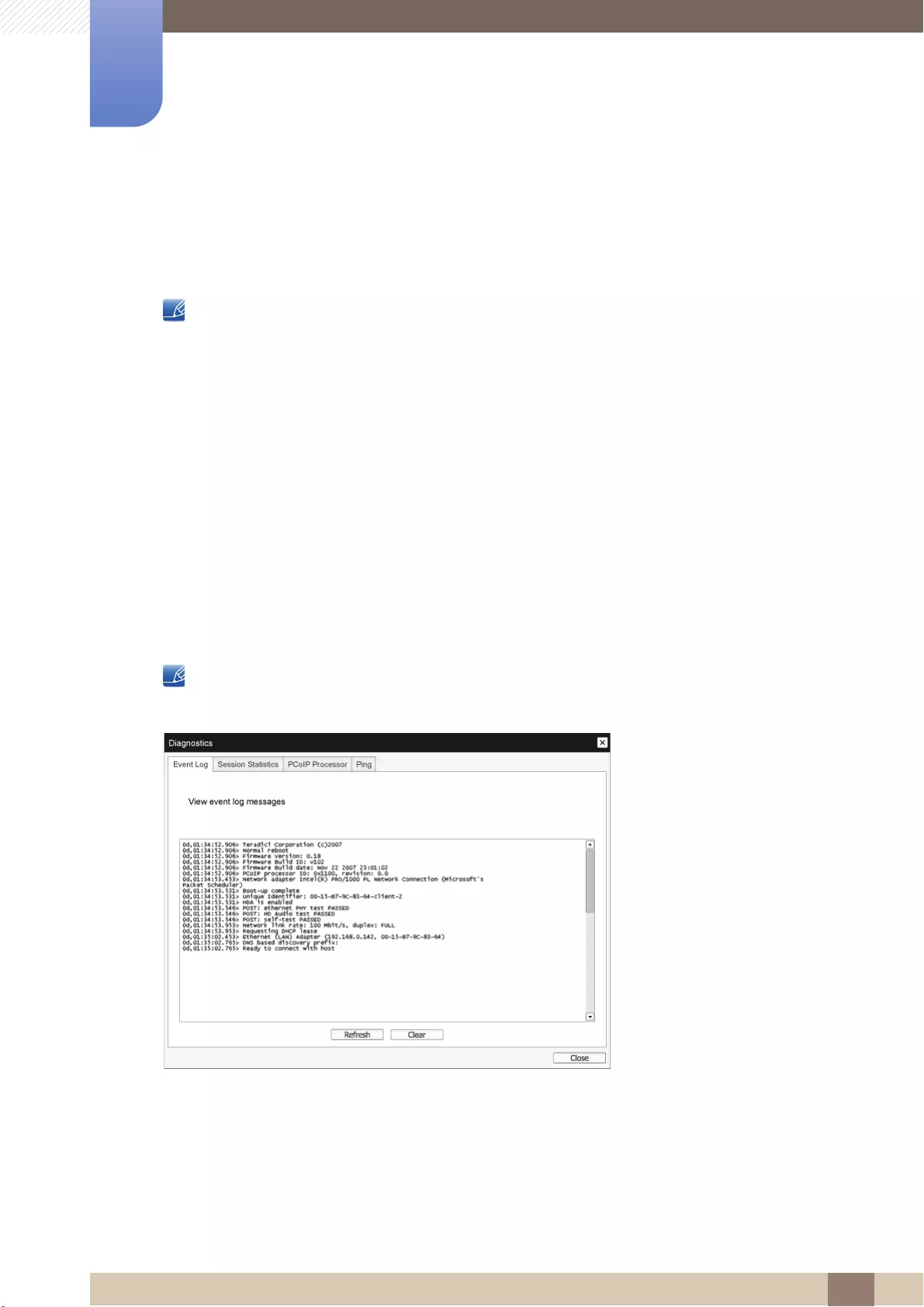
49
Using "PCoIP"
2
2 Using "PCoIP"
2.4.5 Diagnostics Window
The Diagnostic menu contains links to pages with run-time information and functions that may be useful
for troubleshooting.
The Diagnostic options in the OSD are a subset of those available through the Administrative Web
Interface.
Each tab has a Close button to close the window.
Event Log Tab
The Event Log page lets you view and clear event log messages from the host or client.
The Administrative Web Interface allows you to change the log filter setting on the device which controls
the level of detail of the messages in the log. When you set the filter to “terse”, the device will log short
and concise messages.
The Event Log page allows you to enable and define syslog to collect and report events that meet the
IETF standard for logging program messages.
The Event Log can also be initiated using the administrative web interface.
Figure 2-15: Event Log Configuration
View event log messages
The View event log messages field displays log messages with time stamp information. There are
two buttons available.
Refresh
Selecting the Refresh button refreshes the event log messages displayed.
Event Log Session Statistics PCoIP Processor Ping

50
Using "PCoIP"
2
2 Using "PCoIP"
Clear
Click to delete all event log messages stored on the device.
Session Statistics Tab
The Session Statistics page lets you view current statistics when a session is active.
If a session is not active, you can view the statistics from the last session.
Session Statistics can also be viewed using the administrative web interface.
Figure 2-16: Session Statistics Configuration
PCoIP Packets Statistics
PCoIP Packets Sent
The total number of PCoIP packets sent in the current/last session.
PCoIP Packets Received
The total number of PCoIP packets received in the current/last session.
PCoIP Packets Lost
The total number of PCoIP packets lost in the current/last session.
Bytes Statistics
Bytes Sent
The total number of bytes sent in the current/last session.
Bytes Received
The total number of bytes received in the current/last session.
Round Trip Latency
The minimum, average, and maximum roundtrip PCoIP system
(e.g., host to client and then back to host) and network latency in milliseconds (+/- 1 ms).

51
Using "PCoIP"
2
2 Using "PCoIP"
PCoIP Processor Tab
The PCoIP Processor page lets you reset the host or client and view the uptime of the client PCoIP
processor since the last boot.
The PCoIP Processor Uptime can also be viewed in the administrative web interface.
Figure 2-17: PCoIP Processor Configuration

52
Using "PCoIP"
2
2 Using "PCoIP"
Ping Tab
The Ping page allows you to ping a device to see if it is reachable across the IP network.
This may help you determine if a host is reachable. As a result of firmware releases 3.2.0 and later forcing
the “do not fragment” flag in the ping command, you can use this feature to determine the maximum
MTU size.
Figure 2-18: Ping Configuration
Ping Settings
Destination
IP Address or FQDN to ping
Interval
Interval between ping packets
Packet Size
Size of the ping packet
Packets
Sent
Number of ping packets transmitted
Received
Number of ping packets received
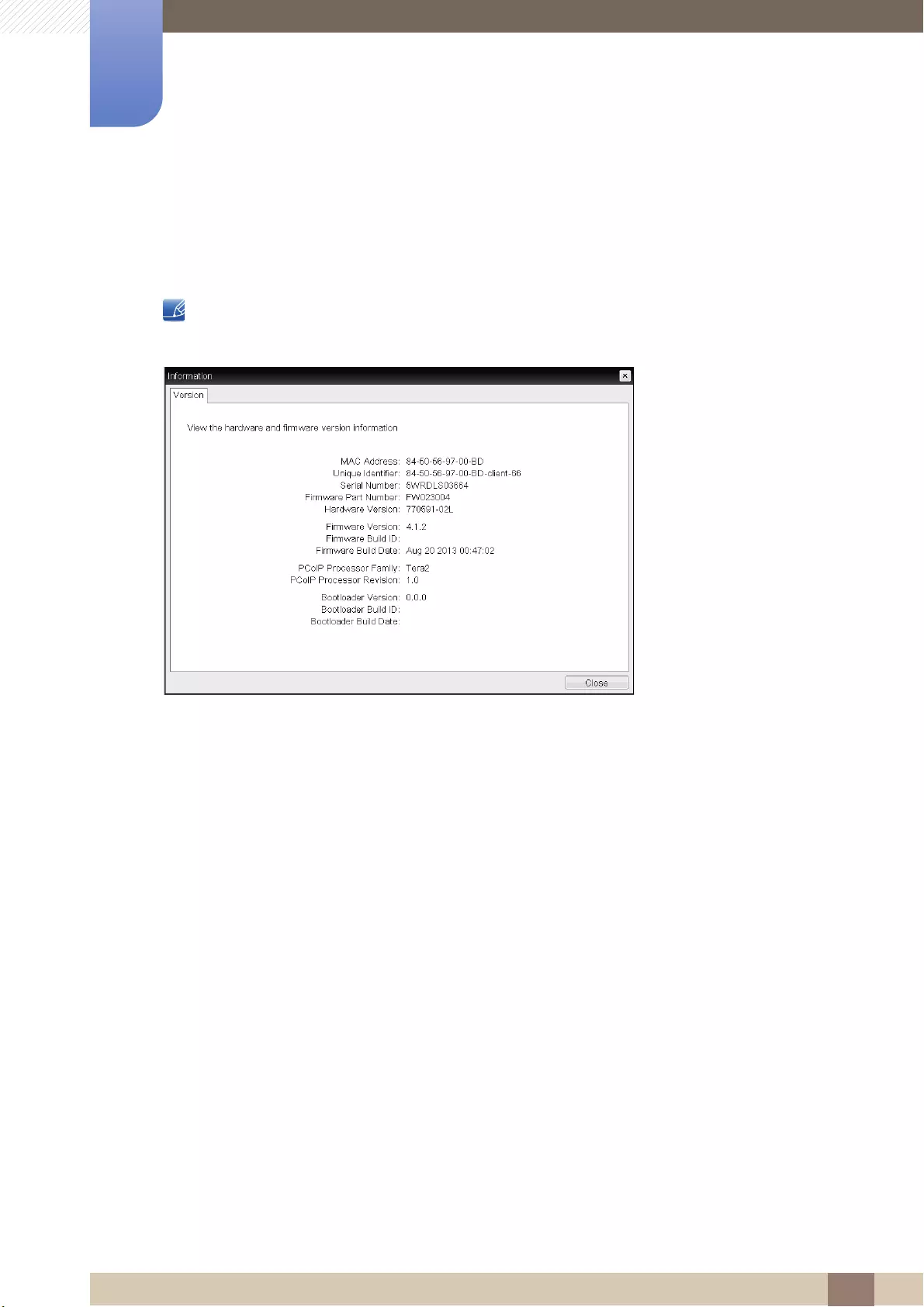
53
Using "PCoIP"
2
2 Using "PCoIP"
2.4.6 Information Window
The Information page lets you see details about the device. The Administrative Web Interface shows
version, VPD, and attached device information. The OSD lets you view the device version information.
The Version page lets you view the hardware and firmware version details for a device.
Figure 2-19: Version Configuration
VPD Information
Vital Product Data (VPD) is information set by the factory to uniquely identify each Portal or Host.
MAC Address
Host/client unique MAC address
Unique Identifier
Host/client unique identifier
Serial Number
Host/client unique serial number
Firmware Part Number
Part number of the current firmware
Hardware Version
Host/client hardware version number
Firmware Information
The Firmware Information reflects the current PCoIP firmware details.
Firmware Version
Version of the current firmware
Firmware Build ID
Revision code of the current firmware

54
Using "PCoIP"
2
2 Using "PCoIP"
Firmware Build Date
Build date for the current firmware
PCoIP Processor Family
The Tera family name is displayed. Tera is a host processor from Teradici.
This product uses a TERA2321 from the newer generation Tera2 host processor family and is
displayed as Tera2.
PCoIP Processor Revision
The silicon revision of the PCoIP processor. Revision B of the silicon is denoted by a 1.0.
Bootloader Information
The Bootloader information reflects the current PCoIP bootloader details.
Bootloader Version
Version of the current bootloader
Bootloader Build ID
Revision code of the current bootloader
Bootloader Build Date
Build date of the current bootloader

55
Using "PCoIP"
2
2 Using "PCoIP"
2.4.7 User Settings Window
The User Settings page allows you to access tabs to define the Certificate Checking Mode, the mouse
and keyboard settings, PCoIP protocol image quality, and display topology.
The tabs in the User Settings menu are:
Certificate Tab
In this tab, select the next steps to take when the security for connection to a server cannot be verified. It
is recommended to change this setting only with approval from the system manager.
Figure 2-20: Certificate Configuration
Never connect to untrusted servers: Select this option if you do not want to connect to a server
that has no certificate or has an untrusted certificate.
Warn before connecting to untrusted servers: Select this option if you want to display a warning
prompt before connecting to an untrusted server.
Do not verify server identity certificates: Select this option if you want to permit connections with
a server without verifying the server ID certificate.
Certificate Mouse Keyboard
Image Display Topology Touch Screen
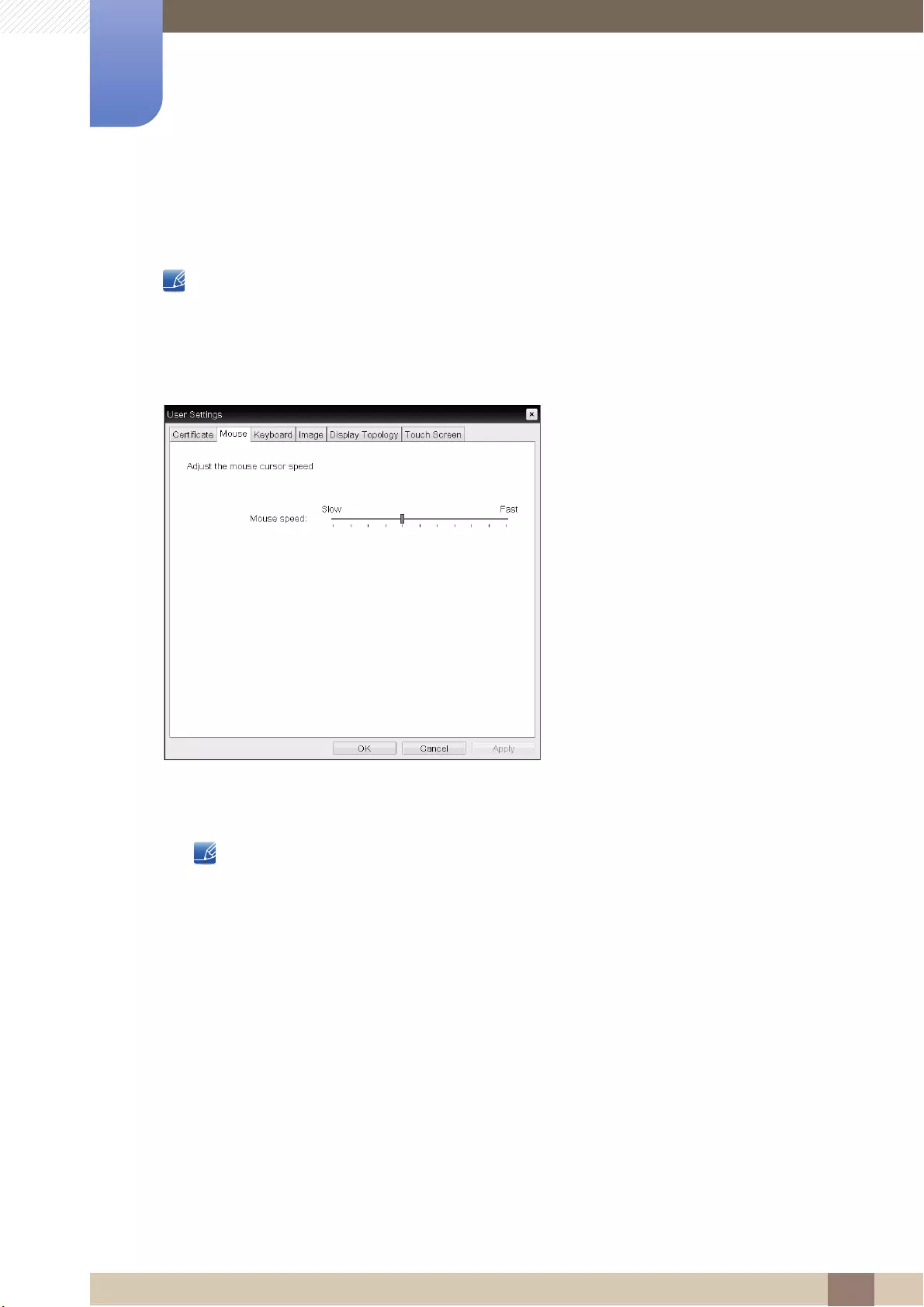
56
Using "PCoIP"
2
2 Using "PCoIP"
Mouse Tab
The Mouse page lets you change the mouse cursor speed settings for the OSD sessions.
The OSD mouse cursor speed setting does not affect the mouse cursor settings when a PCoIP session
is active unless the Local Keyboard Host Driver function is being used. Refer to the "PCoIP Host
Software for Windows User Guide: TER0810001" for more details. This function is only available
through the OSD. It is not available in the Administrative Web Interface.
Figure 2-21: Mouse Configuration
Mouse Speed
Configure the speed of the mouse cursor.
You can also configure the mouse speed through the PCoIP host software. Refer to the "PCoIP
Host Software for Windows User Guide: TER0810001" for more details.

57
Using "PCoIP"
2
2 Using "PCoIP"
Keyboard Tab
The Keyboard page lets you change the keyboard repeat settings for the OSD session.
The keyboard settings do not affect the keyboard settings when a PCoIP session is active unless
the Local Keyboard Host Driver function is used. Refer to the "PCoIP Host Software for Windows
User Guide: TER0810001" for more details. This setting is only available through the OSD. It does
not appear on the Administration Web Interface.
You can also configure the keyboard repeat settings through the PCoIP host software.
Refer to the "PCoIP Host Software for Windows User Guide: TER0810001" for more details.
Figure 2-22: Keyboard Configuration
Keyboard Repeat Delay
Lets users configure the client keyboard repeat delay.
Keyboard Repeat Rate
Lets users configure the client keyboard repeat rate.
Repeat Settings Test Box
Lets users test the chosen keyboard settings.
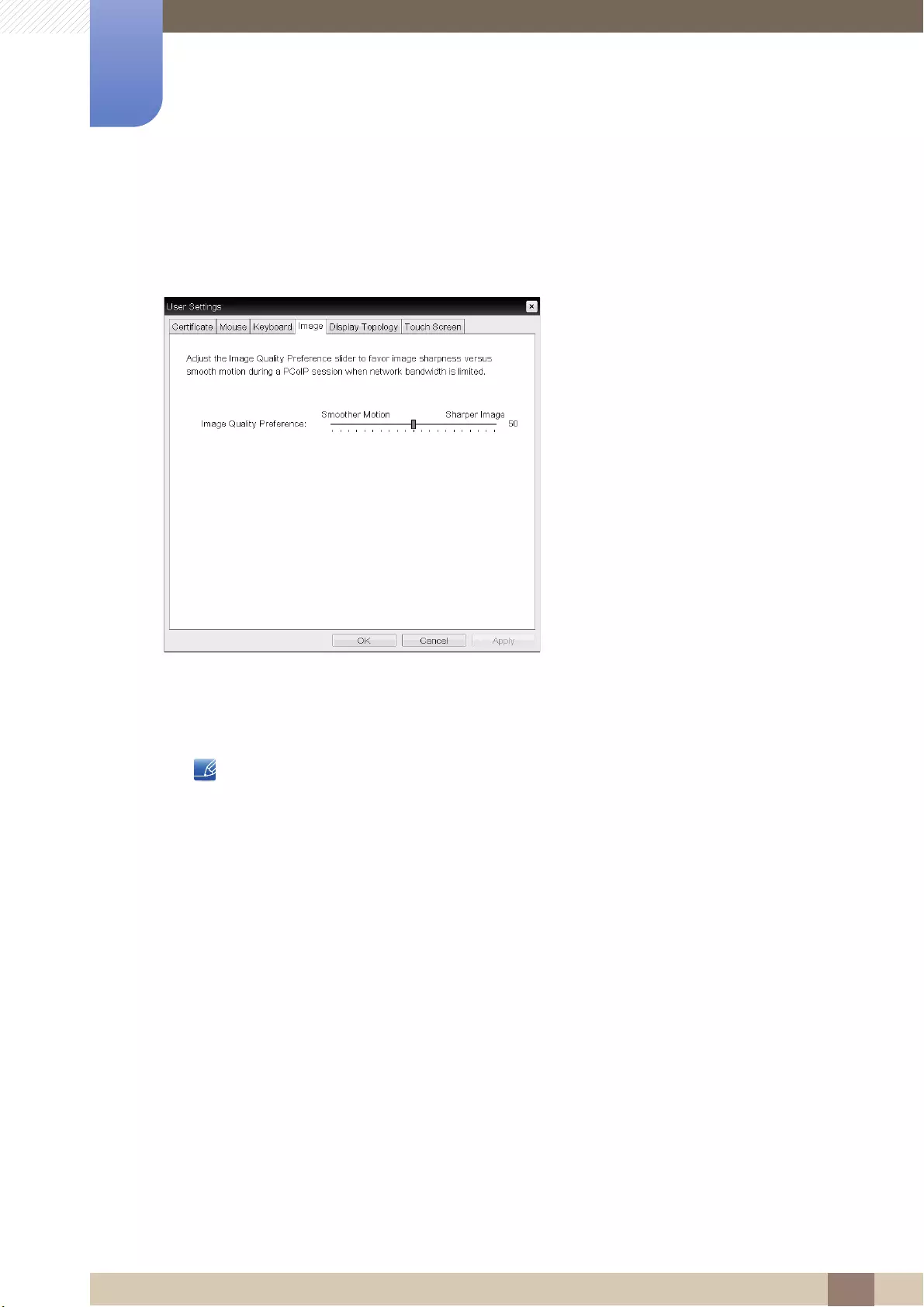
58
Using "PCoIP"
2
2 Using "PCoIP"
Image Tab
The Image page allows you to make changes to the image quality of the PCoIP session.
Figure 2-23: Image Configuration
Image Quality Preference
Use the slider to adjust the balance between image sharpness and smooth motion during a PCoIP
session when network bandwidth is limited.
This field is also accessible on the host if the PCoIP Host Software is installed. The slider can be
found under the Image tab of the host software.

59
Using "PCoIP"
2
2 Using "PCoIP"
Display Topology Tab
To apply the Display Topology feature to a PCoIP session between a zero client and a PCoIP host,
you must have the PCoIP host software installed on the host. Refer to the "PCoIP Host Software for
Windows User Guide: TER0810001" for more details.
The Display Topology tab has no corresponding menu in the Administration Web Interface.
For details about the Display Topology feature for a PCoIP session between a host card and a zero
client, refer to the "PCoIP Host Software for Windows User Guide: TER0810001".
Always change the Display Topology settings using the Display Topology tab on the zero client OSD
Options User Settings interface.
Figure 2-24: Display Topology Configuration
Enable Configuration
The device can be configured with display position, rotation and resolution settings if enabled.
The settings are saved when you click Apply or OK and are applied when the device is reset.
Display Layout
Select whether you want a horizontal or vertical layout for your displays (A and B). This setting should
reflect the physical layout of the displays on your desk.
Horizontal: Select to arrange A and B horizontally, with A located to the left of B.
Vertical: Select to arrange A and B vertically, with A located above B.
A maximum of two displays can be enabled at the same time.

60
Using "PCoIP"
2
2 Using "PCoIP"
Alignment
Select how you want displays A and B aligned when they are different sizes.
This setting affects which area of the screen to use when you move the cursor from one display to
the other. The alignment options that appear in the drop-down list depend on whether you have
selected a horizontal or vertical display layout.
Primary
Configure which DVI port on the zero client that you want as the primary port.
The display that is connected to the primary port becomes the primary display (i.e., the display that
contains the OSD menus before you initiate a PCoIP session and the display that is requested for
the Windows taskbar after you initiate the session).
Port 1: Select to configure DVI-1 port on the zero client as the primary port.
Port 2: Select to configure DVI-2 port on the zero client as the primary port.
Position
Specify which display is physically connected to Port 1 and Port 2.
Rotation
Configure the rotation of the display in Port 1 and Port 2:
No rotation
90˚ clockwise
180˚ rotation
90˚ counter-clockwise
Resolution
The display resolution can be configured for a PCoIP session between a virtual machine or host and
a zero client. The zero client detects the supported display resolutions of the monitor and populates
them to the drop-down menu. By default, the native resolution of the display is used.
Revert
Resets the configurations on this page to their last saved settings.

61
Using "PCoIP"
2
2 Using "PCoIP"
Touch Screen Tab
The Touch Screen page allows you to configure and calibrate certain settings of an attached
Elo TouchSystems touch screen display.
The Touch Screen page is only available through the OSD. It is not available in the Administrative Web
Interface.
Figure 2-25: Touch Screen Configuration
Enable right click on hold
Select this checkbox to allow users to emulate a right-click when they touch the screen and hold it
for a few seconds. If disabled, right-click is not supported.
Right click delay
Slide the pointer to a position between Long and Short to determine how long a user must touch
and hold the screen to emulate a right-click.
Touch screen calibration
When you first connect the touch screen to the zero client, the calibration program will start.
On the touch screen, touch each of the three targets as they appear.
To test the calibration, run your finger along the monitor and ensure that the cursor follows it.
If it is not successful, the calibration program automatically restarts.
Once calibrated, the coordinates are stored in flash.
To manually start the calibration program, from the OSD Touch Screen page,
click Start. Follow the onscreen prompts.

62
Using "PCoIP"
2
2 Using "PCoIP"
2.4.8 Password Window
This option is available through the Management Console Program.
Visit the Teradici Support Site: http://techsupport.teradici.com for further details.
The Password page lets you update the local administrative password for the device.
The Password can be a maximum of 20 characters.
This parameter affects the Administrative Web Interface and the local OSD GUI.
Take care when updating the client password as the client may become unusable if the password
is lost.
Figure 2-26: Change Password Configuration
Old Password
This field must match the current administrative password before you can update the password.
New Password
The new administrative password for both the administrative web interface and the local OSD GUI.
Confirm New Password
This field must match the New Password field for the password to be updated.
Reset
If the client password is lost, you can click the Reset button to request a response code from the
client vendor. The challenge code is sent to the vendor.
The vendor qualifies the request and returns a response code if authorized by Teradici.
When the response code is correctly entered, the password of the client is set to an empty value.
You must enter a new password.
Contact the client vendor for more information when an authorized password reset is required.
This option is not available through the Administrative Web Interface.
It is only available through the OSD.

63
Using "PCoIP"
2
2 Using "PCoIP"
Figure 2-27: Authorized Password Reset Configuration
Details on how to use PCoIP are subject to change without notice.
To view the latest information, visit the Teradici website at http://www.teradici.com.

64
Using "PCoIP"
2
2 Using "PCoIP"
2.4.9 Wake On LAN
This feature allows you to power on the product by sending a pre-determined command from an external
system to the product over a network.
Make sure the network is capable of data communication with the PC that sends the command to the
product. Ensure you have a program that can generate Wake on LAN signals.
Make sure a power supply is always connected to ensure the feature works when the product is
turned off.
The feature is intended to power on the product. (It does not support the function to power off the
product.)
Configuring the settings
1Set the product and PC IP addresses to enable the product to connect to the PC over a network.
2Enter the IP address set for the product in the URL address field on the PC to access the product
administrative web page.
3To change the power settings, log in (Log In) and select Configuration Power.
4Configure the settings to suit the environment in which the product is used. (See the image below.)
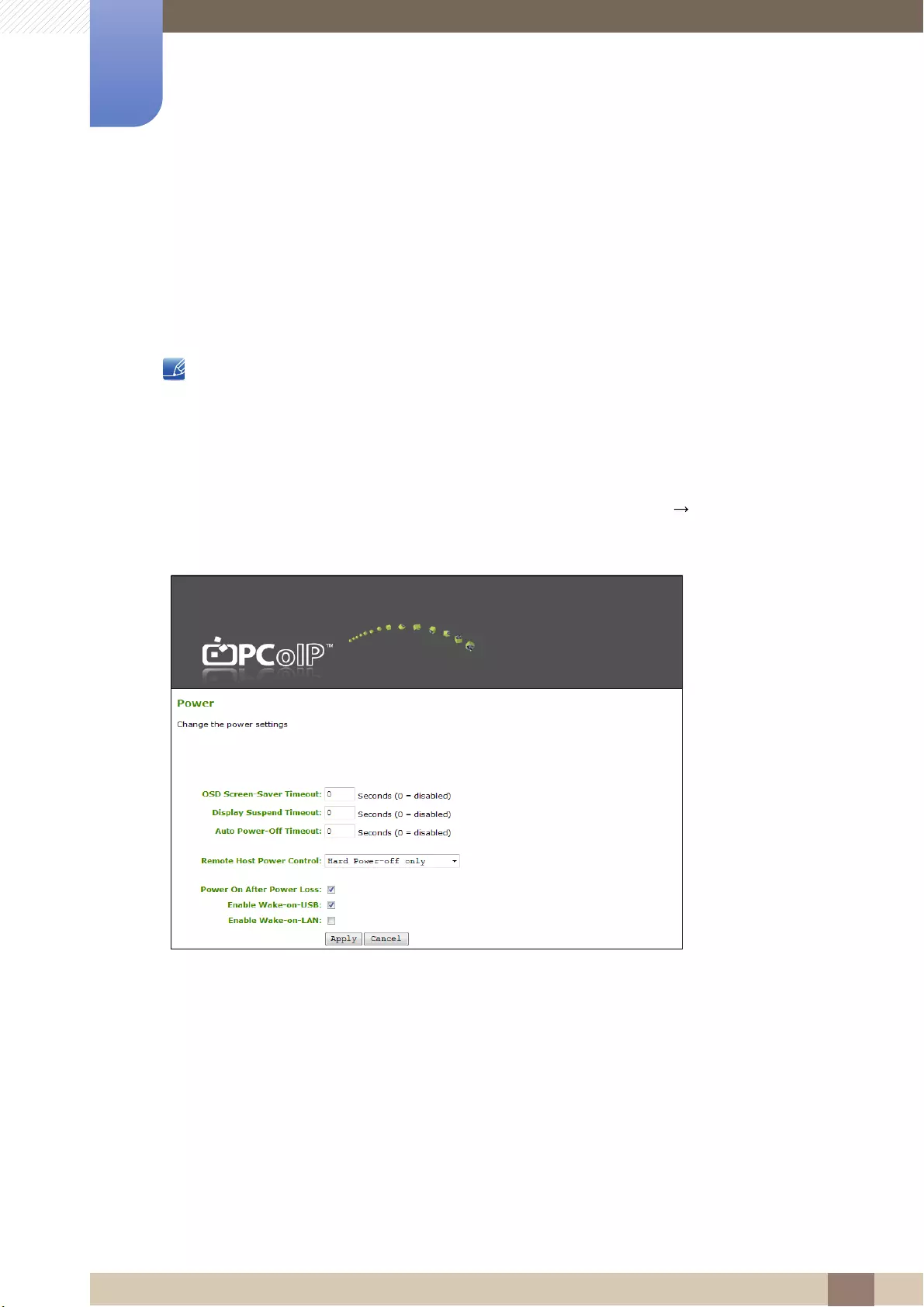
65
Using "PCoIP"
2
2 Using "PCoIP"
2.4.10 Wake on USB
If you turn off the power after activating Wake On USB on the product administrative web page, the
system switches to standby mode.
The Wake on USB feature switches the system from standby mode to normal mode if a change to the
keyboard or mouse input is detected.
Changes include clicking a mouse button or pressing a key on the keyboard.
Configuring the settings
1Set the product and PC IP addresses to enable the product to connect to the PC over a network.
2Enter the IP address set for the product in the URL address field on the PC to access the product
administrative web page.
3To change the power settings, log in (Log In) and select Configuration Power.
4Configure the settings to suit the environment in which the product is used. (See the image below.)

66
Using "PCoIP"
2
2 Using "PCoIP"
2.4.11 OSD Logo Upload
Using the OSD Logo Upload page, change the logo displayed on the Teradici OSD.
Configuring the settings
1Set the product and PC IP addresses to enable the product to connect to the PC over a network.
2Enter the IP address set for the product in the URL address field on the PC to access the product
administrative web page.
3Log in (Log In) and select Upload OSD Logo. The OSD Logo Upload page appears.
(See the image below.)
4Select a new file to replace the logo and press Upload.
Make sure the OSD logo file is a 24bpp Bitmap file that does not exceed 256 x 64 pixels.

67
Using "PCoIP"
2
2 Using "PCoIP"
2.4.12 Firmwre Update
Using the Firmwre Update page, change the Teradici Firmware.
Configuring the settings
1Set the product and PC IP addresses to enable the product to connect to the PC over a network.
2Enter the IP address set for the product in the URL address field on the PC to access the product
administrative web page.
3Log in (Log In) and select Upload Firmware. The Firmware Upload
page appears.
(See the image below.)
4Select a Firmware to replace the logo and press Upload.
5Once upload is complete, the Reset button appears. Click the Reset button to reboot the client.
Go to Options Information, and view the Firmware Version information.

68
3 Connecting and Using a Source Device
3 Connecting and Using a Source Device
3.1 Before Connecting
3.1.1 Pre-connection Checkpoints
Before connecting a source device, read the user manual provided with it.
The number and locations of ports on source devices may differ from device to device.
Do not connect the power cable until all connections are completed.
Connecting the power cable during connection may damage the product.
Check the types of ports at the back of the product you want to connect.

69
Connecting and Using a Source Device
3
3 Connecting and Using a Source Device
3.2 Connecting and Using a PC
3.2.1 Connecting to a PC
Do not connect the power cable before connecting all other cables.
Ensure you connect a source device first before connecting the power cable.
Select a connection method suitable for your PC.
Connecting parts may differ in different products.
Connection Using the D-SUB Cable (Analogue Type)
1Connect the D-SUB cable to the [RGB IN] port on the back of the product and the RGB port on the
PC.
2Connect the DC power adapter to the product and a power socket. Next, turn on the power switch
on the PC.
(For details, refer to "2.2.6 Connecting the Power".)
3Press [ ] to change the input source to Analog.
Connecting a Stereo Cable
Connect the [AUDIO IN] port on the rear side of the monitor to the sound card of the PC.
RGB IN
AUDIO IN

70
Connecting and Using a Source Device
3
3 Connecting and Using a Source Device
3.2.2 "Windows Driver" Installation
You can set the optimum resolution and frequency for this product by installing the corresponding
drivers.
An installation driver is contained on the CD supplied with the product.
1Insert the user manual CD provided with the product into the CD-ROM drive.
2Click "Windows Driver".
3Follow the instructions given on the screen to proceed with installation.
4Select your product model from the list of models.
5Go to Display Properties and check that the resolution and refresh rate are appropriate.
Refer to your Windows OS manual for further details.

71
Connecting and Using a Source Device
3
3 Connecting and Using a Source Device
3.2.3 Setting Optimum Resolution
An information message about setting optimum resolution will appear if you power on the product for the
first time after purchase.
Select a language and change the resolution to the optimum value.
1Press [ ] to move to the language you want and press [ ].
2To hide the information message, press [ ].
If the optimum resolution is not selected, the message will appear up to three times for a specified
time even when the product is turned off and on again.
If the product is used as standard monitor, the optimum resolution can be configured from Control
Panel on a PC.
To configure the resolution when using the product as a network monitor, refer to "2.4 "PCoIP"".
A
UT
O
1920 x 1080 60Hz
The optimal resolution for this monitor is as follows:
Follow the above settings to set the resolution.
English
M
ENU
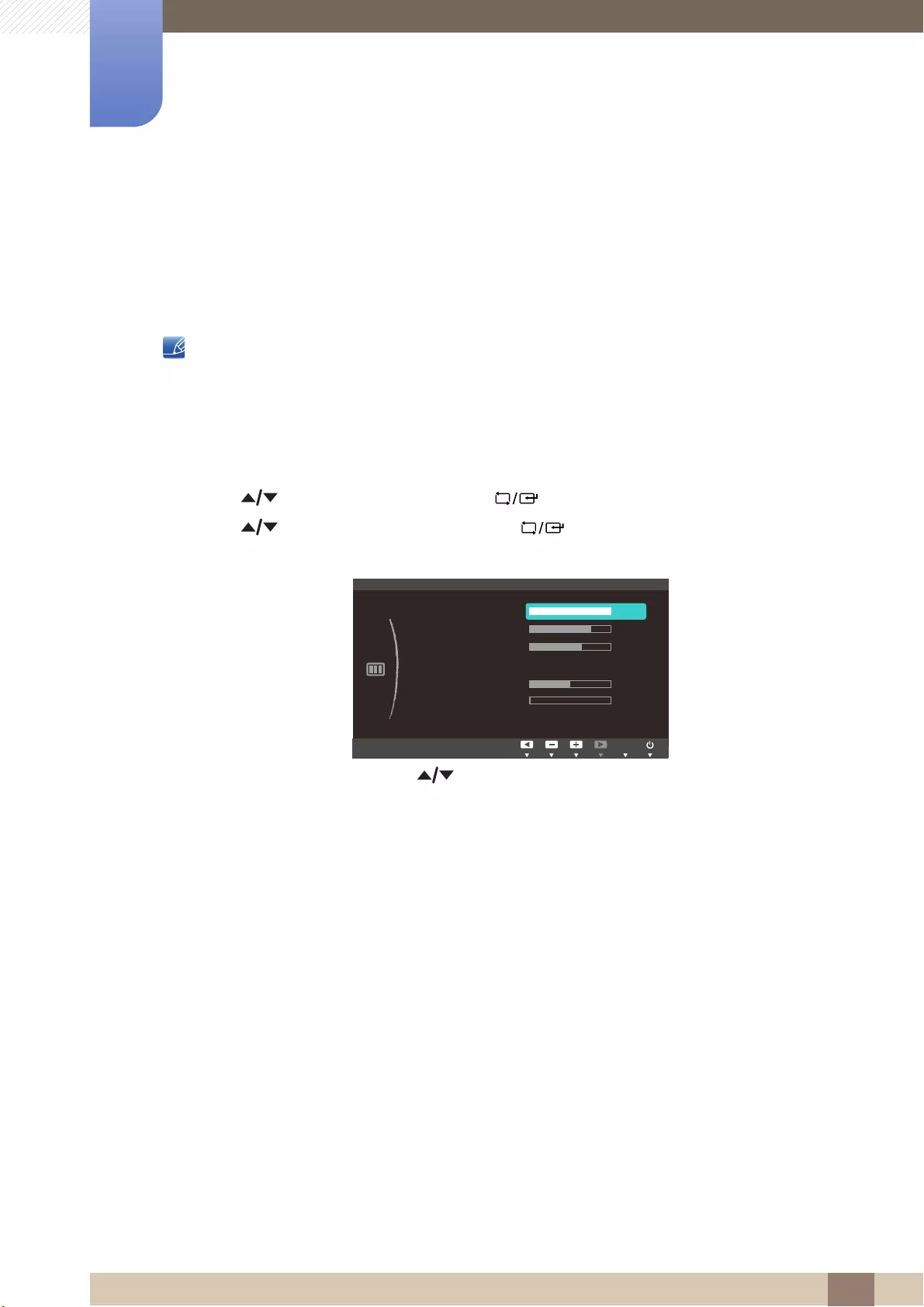
72
4 Screen Setup
4 Screen Setup
Configure the screen settings such as brightness and color tone.
4.1 Brightness
You can adjust the general brightness of the picture. (Range: 0~100)
A higher value will make the picture appear brighter.
This menu is not available when Bright is set to Dynamic Contrast mode.
4.1.1 Configuring Brightness
1Press any button on the front of the product to display the OSD guide. Next, press [ ] to display
the corresponding menu screen.
2Press [ ] to move to Picture and press [ ] on the product.
3Press [ ] to move to Brightness and press [ ] on the product. The following screen will
appear.
4Adjust the Brightness using the [ ] buttons.
5The selected option will be applied.
SAMSUNG
MAGIC
M
ENU
ࢇࢷ֩Ѝ ۴࣏ࢽ
:
:
:
: Custom
:
:
PICTURE
Brightness
Contrast
Sharpness
Coarse
Fine
SAMSUNG
MAGIC Bright
AUTO

73
Screen Setup
4
4 Screen Setup
4.2 Contrast
Adjust the contrast between the objects and background. (Range: 0~100)
A higher value will increase the contrast to make the object appear clearer.
This menu is not available when Bright is in Cinema or Dynamic Contrast mode.
This menu is not available when Color is in Full or Intelligent mode.
4.2.1 Configuring Contrast
1Press any button on the front of the product to display the OSD guide. Next, press [ ] to display
the corresponding menu screen.
2Press [ ] to move to Picture and press [ ] on the product.
3Press [ ] to move to Contrast and press [ ] on the product. The following screen will
appear.
4Adjust the Contrast using the [ ] buttons.
5The selected option will be applied.
SAMSUNG
MAGIC
SAMSUNG
MAGIC
M
ENU
ࢇࢷ֩Ѝ ۴࣏ࢽ
:
:
:
: Custom
:
:
PICTURE
Brightness
Contrast
Sharpness
Coarse
Fine
ࢇࢷ֩Ѝ ۴࣏ࢽ
AUTO
SAMSUNG
MAGIC
Bright
AUTO

74
Screen Setup
4
4 Screen Setup
4.3 Sharpness
Make the outline of objects more clear or blurry. (Range: 0~100)
A higher value will make the outline of objects clearer.
This menu is not available when Bright is in Cinema or Dynamic Contrast mode.
This menu is not available when Color is in Full or Intelligent mode.
4.3.1 Configuring Sharpness
1Press any button on the front of the product to display the OSD guide. Next, press [ ] to display
the corresponding menu screen.
2Press [ ] to move to Picture and press [ ] on the product.
3Press [ ] to move to Sharpness and press [ ] on the product. The following screen will
appear.
4Adjust the Sharpness using the [ ] buttons.
5The selected option will be applied.
SAMSUNG
MAGIC
SAMSUNG
MAGIC
M
ENU
ࢇࢷ֩Ѝ ۴࣏ࢽ
:
:
:
: Custom
:
:
PICTURE
Brightness
Contrast
Sharpness
Coarse
Fine
ࢇࢷ֩Ѝ ۴࣏ࢽ
AUTO
SAMSUNG
MAGIC
Bright
AUTO

75
Screen Setup
4
4 Screen Setup
4.4 SAMSUNG MAGIC Bright
This menu provides an optimum picture quality suitable for the environment where the product will be
used.
You can customize the brightness to suit your preferences.
4.4.1 Configuring SAMSUNG MAGIC Bright
1Press any button on the front of the product to display the OSD guide. Next, press [ ] to display
the corresponding menu screen.
2Press [ ] to move to Picture and press [ ] on the product.
3Press [ ] to move to Bright and press [ ] on the product. The following screen will
appear.
Custom: Customize the contrast and brightness as required.
Standard: Obtain a picture quality suitable for editing documents or using Internet.
Game: Obtain a picture quality suitable for playing games that involve many graphic effects and
dynamic movements.
Cinema: Obtain the brightness and sharpness of TVs suitable for enjoying video and DVD
content.
Dynamic Contrast: Obtain balanced brightness through automatic contrast adjustment.
4Press [ ] to move to the option you want and press [ ].
5The selected option will be applied.
M
ENU
SAMSUNG
MAGIC
ࢇࢷ֩Ѝ ۴࣏ࢽ
:
:
:
: Custom
: Off
:
PICTURE
Brightness
Contrast
Sharpness
Coarse
Fine
AUTO
SAMSUNG
MAGIC
Bright
Custom
Standard
Game
Cinema
Dynamic Contrast
AUTO
MENU

76
Screen Setup
4
4 Screen Setup
4.5 Coarse
Adjust the screen frequency.
This menu is available in Analog mode only.
4.5.1 Adjusting Coarse
1Press any button on the front of the product to display the OSD guide. Next, press [ ] to display
the corresponding menu screen.
2Press [ ] to move to Picture and press [ ] on the product.
3Press [ ] to move to Coarse and press [ ] on the product. The following screen will
appear.
4Adjust the Coarse using the [ ] buttons.
5The selected option will be applied.
M
ENU
ࢇࢷ֩Ѝ ۴࣏ࢽ
:
:
:
: Custom
:
:
PICTURE
Brightness
Contrast
Sharpness
Coarse
Fine
ࢇࢷ֩Ѝ ۴࣏ࢽ
AUTO
SAMSUNG
MAGIC
Bright
AUTO

77
Screen Setup
4
4 Screen Setup
4.6 Fine
Fine-adjust the screen to obtain a vivid picture.
This menu is available in Analog mode only.
4.6.1 Adjusting Fine
1Press any button on the front of the product to display the OSD guide. Next, press [ ] to display
the corresponding menu screen.
2Press [ ] to move to Picture and press [ ] on the product.
3Press [ ] to move to Fine and press [ ] on the product. The following screen will appear.
4Adjust the Fine using the [ ] buttons.
5The selected option will be applied.
M
ENU
ࢇࢷ֩Ѝ ۴࣏ࢽ
:
:
:
: Custom
:
:
PICTURE
Brightness
Contrast
Sharpness
Coarse
Fine
ࢇࢷ֩Ѝ ۴࣏ࢽ
AUTO
SAMSUNG
MAGIC Bright
AUTO

78
5 Configuring Tint
5 Configuring Tint
Adjust the tint of the screen. This menu is not available when Bright is set to Cinema or
Dynamic Contrast mode.
SAMSUNG
MAGIC
5.1 SAMSUNG MAGIC Color
Color is a new picture-quality improvement technology developed independently by Samsung,
which delivers vivid natural colors without picture quality degradation.
5.1.1 Configuring SAMSUNG MAGIC Color
1Press any button on the front of the product to display the OSD guide. Next, press [ ] to display
the corresponding menu screen.
2Press [ ] to move to COLOR and press [ ] on the product.
3Press [ ] to move to Color and press [ ] on the product. The following screen will
appear.
Off: Disable Color.
Demo: Compare normal screen mode with Color mode.
Full: Obtain a vivid picture quality for all areas including the flesh colors in the picture.
Intelligent: Improve the chroma for all areas except the flesh colors in the picture.
4Press [ ] to move to the option you want and press [ ].
5The selected option will be applied.
SAMSUNG
MAGIC
MENU
SAMSUNG
MAGIC
COLOR
ࢇࢷ֩Ѝ ࣏ࢽ ۴
Off
Demo
Full
Intelligent
:
:
:
:
:
:
SAMSUNG
MAGIC
Color
Red
Green
Blue
Color Tone
Gamma Mode 1
Normal
AUTO AUTO
SAMSUNG
MAGIC
SAMSUNG
MAGIC
MENU

79
Configuring Tint
5
5 Configuring Tint
5.2 Red
Adjust the value of the color red in the picture. (Range: 0~100)
A higher value will increase the intensity of the color.
This menu is not available when Color is in Full or Intelligent mode.
5.2.1 Configuring Red
1Press any button on the front of the product to display the OSD guide. Next, press [ ] to display
the corresponding menu screen.
2Press [ ] to move to COLOR and press [ ] on the product.
3Press [ ] to move to Red and press [ ] on the product. The following screen will appear.
4Adjust the Red using the [ ] buttons.
5The selected option will be applied.
SAMSUNG
MAGIC
MENU
COLOR
ࢇࢷ֩Ѝ ࣏ࢽ ۴
:
:
:
:
:
:
SAMSUNG
MAGIC
Color
Red
Green
Blue
Color Tone
Gamma Mode 1
Normal
Off
ࢇࢷ֩Ѝ ۴࣏ࢽ
AUTO
AUTO

80
Configuring Tint
5
5 Configuring Tint
5.3 Green
Adjust the value of the color green in the picture. (Range: 0~100)
A higher value will increase the intensity of the color.
This menu is not available when Color is in Full or Intelligent mode.
5.3.1 Configuring Green
1Press any button on the front of the product to display the OSD guide. Next, press [ ] to display
the corresponding menu screen.
2Press [ ] to move to COLOR and press [ ] on the product.
3Press [ ] to move to Green and press [ ] on the product. The following screen will appear.
4Adjust the Green using the [ ] buttons.
5The selected option will be applied.
SAMSUNG
MAGIC
MENU
COLOR
ࢇࢷ֩Ѝ ࣏ࢽ ۴
:
:
:
:
:
:
SAMSUNG
MAGIC Color
Red
Green
Blue
Color Tone
Gamma Mode 1
Normal
Off
ࢇࢷ֩Ѝ ۴࣏ࢽ
AUTO AUTO

81
Configuring Tint
5
5 Configuring Tint
5.4 Blue
Adjust the value of the color blue in the picture. (Range: 0~100)
A higher value will increase the intensity of the color.
This menu is not available when Color is in Full or Intelligent mode.
5.4.1 Configuring Blue
1Press any button on the front of the product to display the OSD guide. Next, press [ ] to display
the corresponding menu screen.
2Press [ ] to move to COLOR and press [ ] on the product.
3Press [ ] to move to Blue and press [ ] on the product. The following screen will appear.
4Adjust the Blue using the [ ] buttons.
5The selected option will be applied.
SAMSUNG
MAGIC
MENU
COLOR
ࢇࢷ֩Ѝ ࣏ࢽ ۴
:
:
:
:
:
:
SAMSUNG
MAGIC Color
Red
Green
Blue
Color Tone
Gamma Mode 1
Normal
Off
ࢇࢷ֩Ѝ ۴࣏ࢽ
AUTO AUTO

82
Configuring Tint
5
5 Configuring Tint
5.5 Color Tone
Adjust the general color tone of the picture.
This menu is not available when Color is in Full or Intelligent mode.
5.5.1 Configuring the Color Tone Settings
1Press any button on the front of the product to display the OSD guide. Next, press [ ] to display
the corresponding menu screen.
2Press [ ] to move to COLOR and press [ ] on the product.
3Press [ ] to move to Color Tone and press [ ] on the product. The following screen will
appear.
Cool 2: Set the color temperature to be cooler than Cool 1.
Cool 1: Set the color temperature to be cooler than Normal mode.
Normal: Display the standard color tone.
Warm 1: Set the color temperature to be warmer than Normal mode.
Warm 2: Set the color temperature to be warmer than Warm 1.
Custom: Customize the color tone.
4Press [ ] to move to the option you want and press [ ].
5The selected option will be applied.
SAMSUNG
MAGIC
M
ENU
COLOR
ࢇࢷ֩Ѝ ࣏ࢽ ۴
:
:
:
:
:
:
SAMSUNG
MAGIC
Color
Red
Green
Blue
Color Tone
Gamma ֻҖ
ࣱ
Off
Cool 2
Cool 1
Normal
Warm 1
Warm 2
Custom
AUTO AUTO
MENU

83
Configuring Tint
5
5 Configuring Tint
5.6 Gamma
Adjust the mid-range brightness (Gamma) of the picture.
5.6.1 Configuring Gamma
1Press any button on the front of the product to display the OSD guide. Next, press [ ] to display
the corresponding menu screen.
2Press [ ] to move to COLOR and press [ ] on the product.
3Press [ ] to move to Gamma and press [ ] on the product. The following screen will
appear.
4Press [ ] to move to the option you want and press [ ].
5The selected option will be applied.
M
ENU
COLOR
ࢇࢷ֩Ѝ ࣏ࢽ ۴
:
:
:
:
:
:
SAMSUNG
MAGIC Color
Red
Green
Blue
Color Tone
Gamma ֻҖ
Normal
Off
AUTO
Mode1
Mode2
Mode3
AUTO
MENU

84
6 Resizing or Relocating the Screen
6 Resizing or Relocating the Screen
6.1 H-Position & V-Position
H-Position: Move the screen to the left or right.
V-Position: Move the screen up or down.
This menu is available in Analog mode only.
6.1.1 Configuring H-Position & V-Position
1Press any button on the front of the product to display the OSD guide. Next, press [ ] to display
the corresponding menu screen.
2Press [ ] to move to SIZE&POSITION and press [ ] on the product.
3Press [ ] to move to H-Position or V-Position, and press [ ]. The following screen will
appear.
4Press [ ] to configure H-Position or V-Position.
5The selected option will be applied.
M
ENU
ࢇࢷ֩Ѝ ۴࣏ࢽ
:
:
:
:
SIZE&POSITION
H-Position
V-Position
Menu H-Position
Menu V-Position 1
50
50
50
AUTO AUTO
ࢇࢷ֩Ѝ ۴࣏ࢽ
:
:
:
:
SIZE&POSITION
H-Position
V-Position
Menu H-Position
Menu V-Position 1
50
50
50
AUTO AUTO

85
Resizing or Relocating the Screen
6
6 Resizing or Relocating the Screen
6.2 Menu H-Position & Menu V-Position
Menu H-Position: Move the menu position to the left or right.
Menu V-Position: Move the menu position up or down.
6.2.1 Configuring Menu H-Position & Menu V-Position
1Press any button on the front of the product to display the OSD guide. Next, press [ ] to display
the corresponding menu screen.
2Press [ ] to move to SIZE&POSITION and press [ ] on the product.
3Press [ ] to move to Menu H-Position or Menu V-Position, and press [ ]. The following
screen will appear.
4Press [ ] to configure Menu H-Position or Menu V-Position.
5The selected option will be applied.
M
ENU
ࢇࢷ֩Ѝ ۴࣏ࢽ
:
:
:
:
SIZE&POSITION
H-Position
V-Position
Menu H-Position
Menu V-Position 1
50
50
AUTO
50
AUTO
ࢇࢷ֩Ѝ ۴࣏ࢽ
:
:
:
:
SIZE&POSITION
H-Position
V-Position
Menu H-Position
Menu V-Position
50
50
AUTO
50
1
AUTO

86
7 Setup and Reset
7 Setup and Reset
7.1 Reset
Return all the settings for the product to the default factory settings.
7.1.1 Initializing Settings (Reset)
1Press any button on the front of the product to display the OSD guide. Next, press [ ] to display
the corresponding menu screen.
2Press [ ] to move to SETUP&RESET and press [ ] on the product.
3Press [ ] to move to Reset and press [ ] on the product. The following screen will appear.
4Press [ ] to move to the option you want and press [ ].
5The selected option will be applied.
M
ENU
ࢇࢷ֩Ѝ ۴ࢇѰ
SETUP&RESET
20 sec
On
Power Off
English
Reset
Language
Display Time
Menu Transparency
Power Key
ࢇࢷ֩Ѝ ۴࣏ࢽ
ࢇࢷ֩Ѝ ࣏ࢽ ۴
AUTO
No
Yes
AUTO
MENU

87
Setup and Reset
7
7 Setup and Reset
7.2 Language
Set the menu language.
A change to the language setting will only be applied to the onscreen menu display.
It will not be applied to other functions on your PC.
7.2.1 Changing the Language
1Press any button on the front of the product to display the OSD guide. Next, press [ ] to display
the corresponding menu screen.
2Press [ ] to move to SETUP&RESET and press [ ] on the product.
3Press [ ] to move to Language and press [ ] on the product. The following screen will
appear.
4Press [ ] to move to the language you want and press [ ].
5The selected option will be applied.
M
ENU
ࢇࢷ֩Ѝ ۴ࢇѰ
SETUP&RESET
AUTO
'HXWVFK
(QJOLVK
(VSDxRO
)UDQoDLV
,WDOLDQR
0DJ\DU
3ROVNL
3RUWXJXrV
ƧNJLjLjǁƿǀ
6YHQVND
7UNoH
ଞ˲߭
∝䇁
ᣣᧄ⺆
Reset
Language
Display Time
Menu Transparency
Power Key
AUTO
MENU

88
Setup and Reset
7
7 Setup and Reset
7.3 Display Time
Set the on-screen display (OSD) menu to automatically disappear if the menu is not used for a specified
period of time.
Display Time can be used to specify the time after which you want the OSD menu to disappear.
7.3.1 Configuring Display Time
1Press any button on the front of the product to display the OSD guide. Next, press [ ] to display
the corresponding menu screen.
2Press [ ] to move to SETUP&RESET and press [ ] on the product.
3Press [ ] to move to Display Time and press [ ] on the product. The following screen will
appear.
4Press [ ] to move to the option you want and press [ ].
5The selected option will be applied.
M
ENU
SETUP&RESET
Adjust EnterReturn
AUTO
5 sec
10 sec
20 sec
200 sec
English
Reset
Language
Display Time
Menu Transparency
Power Key
AUTO
MENU

89
Setup and Reset
7
7 Setup and Reset
7.4 Menu Transparency
Set the transparency for the menu windows:
7.4.1 Changing Menu Transparency
1Press any button on the front of the product to display the OSD guide. Next, press [ ] to display
the corresponding menu screen.
2Press [ ] to move to SETUP&RESET and press [ ] on the product.
3Press [ ] to move to Menu Transparency and press [ ] on the product. The following
screen will appear.
4Press [ ] to move to the option you want and press [ ].
5The selected option will be applied.
M
ENU
SETUP&RESET
Adjust EnterReturn
AUTO
Off
On
20 sec
English
Reset
Language
Display Time
Menu Transparency
Power Key
AUTO
MENU

90
Setup and Reset
7
7 Setup and Reset
7.5 Power Key
The power button on the product is used to perform two functions.
The default setting is Power Off.
7.5.1 Enabling Power Key
1Press any button on the front of the product to display the OSD guide. Next, press [ ] to display
the corresponding menu screen.
2Press [ ] to move to SETUP&RESET and press [ ] on the product.
3Press [ ] to move to Power Key and press [ ]. The following screen will appear.
If Screen Off is selected, use the power button as follows:
Turning off the screen: Press the power button. A message appears: "The screen will turn
off in 5 seconds. Power Off: Press & hold for 2 seconds." After 5 seconds, the screen
switches off. The power indicator on the front of the product alternates between turning off
for 3 seconds and turning on for one second.
Turning on the screen/power: Press the power button.
Turning off the power: Press the power button for more than 2 seconds.
To turn the product on or off when Power Off is selected, press the power button.
4Press [ ] to move to the option you want and press [ ].
5The selected option will be applied.
M
ENU
SETUP&RESET
Screen Off
Power Off
20 sec
English
On
Reset
Language
Display Time
Menu Transparency
Power Key
AUTO
MENU

91
8 INFORMATION Menu and Others
8 INFORMATION Menu and Others
8.1 INFORMATION
View the current input source, frequency and resolution.
8.1.1 Displaying INFORMATION
1Press any button on the front of the product to display the OSD guide. Next, press [ ] to display
the corresponding menu screen.
2Press [ ] to move to INFORMATION. The current input source, frequency and resolution will
appear.
The displayed menu items may vary depending on the model.
8.2 Configuring Volume in the Initial Screen
Adjust the Volume by pressing the [ ] button when the OSD guide is displayed.
1Press any button on the front of the product (when no menu screen is displayed) to display the OSD
guide. Next, press [ ].
2The following screen will appear.
3Adjust the Volume using the [ ] buttons.
M
ENU
SETUP&RESET
Analog
64.0kHz 60Hz PP
1280 x 1024
֩ЍیԂ ۴࣏ࢽ
PICTURE
COLOR
SIZE&POSITION
INFORMATION
AUTOEXIT
A
UT
O
9ROXPH
50
EXIT

92
9 Installing the Software
9 Installing the Software
9.1 Natural Color
9.1.1 What is Natural Color?
One of the problems with using a PC is that the colors you see on the screen are different from the colors
of printed pictures or source images input through a scanner or digital camera. Natural Color is a color
management system developed by Samsung Electronics to resolve this problem. This software works
with Samsung products only and enables you to adjust the displayed colors on the screen to match the
colors of the printed pictures. For more information, refer to the online help of the software (F1).
The Natural Color is provided online. You can download it from the website below and install;
http://www.samsung.com/us/consumer/learningresources/monitor/naturalcolorexpert/pop_download.html

93
Installing the Software
9
9 Installing the Software
9.2 MultiScreen
The MultiScreen program can be installed on the VDI server's virtual machine or on a host PC with a
compatible Windows-series operating system.
Virtual Desktop Infrastructure: a PC equipped with VMware View and Teradici Hostcard
MultiScreen enables users to use the monitor by partitioning multiple sections.
9.2.1 Installing the Software
1Insert the installation CD into the [CD-ROM] drive.
2Select the "MultiScreen" setup program.
If the pop-up screen for the software installation does not appear on the main screen, find and
double-click the "MultiScreen" setup file on the [CD-ROM].
3When the Installation Wizard appears, click "Next".
4Follow the instructions given on the screen to proceed with installation.
The software may not work properly if you do not restart the computer after the installation.
The "MultiScreen" icon may not appear depending on the computer system and the product
specifications.
If the shortcut icon does not appear, press the "F5" key.
Restrictions and Problems with the Installation (MultiScreen)
The "MultiScreen" installation may be affected by the Graphics card, Motherboard and the Networking
environment.
Operating System
"OS"
"Windows 2000"
"Windows XP Home Edition"
"Windows XP Professional"
"Windows Vista 32bit"
"Windows 7 32bit"
"Windows 8 32bit"
For "MultiScreen", the operating systems "Windows 2000" or later is recommended.
MultiScreen

94
Installing the Software
9
9 Installing the Software
"Hardware"
At least 32MB of memory
At least 60MB of free space on the hard disk drive
9.2.2 Removing the Software
Click [Start], select [Settings]/[Control Panel], and then double-click [Add or Remove Programs].
Select "MultiScreen" from the program list and click the [Add/Delete] button.

95
10 Troubleshooting Guide
10 Troubleshooting Guide
10.1 Requirements Before Contacting Samsung Customer
Service Center
10.1.1 Testing the Product
Before calling Samsung Customer Service Center, test your product as follows. If the problem persists,
contact Samsung Customer Service Center.
Check if your product is operating normally by using the product test function.
If the screen is turned off and the power indicator blinks even though the product is properly connected
to a PC, perform a self-diagnosis test.
1Power off both the PC and product.
2Disconnect the cables from the product.
3Power on the product.
4If the message "Check Signal Cable" appears, the product is working normally.
If the screen remains blank, check the PC system, video controller and cable.
10.1.2 Checking the Resolution and Frequency
For a mode that exceeds the supported resolution (refer to "11.2 Standard Signal Mode Table"), the
message "Not Optimum Mode" will appear for a short time.
10.1.3 Check the following.
Installation issue (PC mode)
Issues Solutions
The screen keeps switching on and off. Check the cable connection between the product
and PC, and ensure the connectors are locked.
(Refer to "3.2 Connecting and Using a PC")

96
Troubleshooting Guide
10
10 Troubleshooting Guide
Screen issue
Issues Solutions
The power LED is off. The screen will not switch
on.
Check that the power cable is connected
properly. (Refer to "3.2 Connecting and Using a
PC")
The message "Check Signal Cable" appears. Check that the cable is properly connected to the
product. (Refer to "3.2 Connecting and Using a
PC")
Check that the device connected to the product is
powered on.
Not Optimum Mode is displayed. This message appears if the signal from the
graphics card exceeds the maximum resolution or
frequency for the product.
Change the maximum resolution and frequency to
suit the product performance, referring to
Standard Signal Mode Table (page 102).
The images on the screen look distorted. Check the cable connection to the product (Refer
to "3.2 Connecting and Using a PC")
The screen is not clear. The screen is blurry. Adjust Coarse(page 76) and Fine(page 77).
Remove any accessories (video extension cable,
etc.) and try again.
Set the resolution and frequency to the
recommended level. (Refer to "11.1 General")
The screen appears unstable and shaky. Check that the resolution and frequency for the
PC are within the range of resolution and
frequency compatible with the product. Next, if
required, change the settings, referring to
Standard Signal Mode Table (page 102) in this
manual and the INFORMATION menu on the
product.
There are shadows or ghost images left on the
screen.
The screen is too bright. The screen is too dark. Adjust Brightness(page 72) and Contrast(page
73).
Screen color is inconsistent. Change the COLOR settings.
(Refer to " Configuring Tint")
The colors on the screen have a shadow and are
distorted.
Change the COLOR settings.
(Refer to " Configuring Tint")
White does not really look white. Change the COLOR settings.
(Refer to " Configuring Tint")

97
Troubleshooting Guide
10
10 Troubleshooting Guide
Sound issue
Source device issue
There is no image on the screen and the power
LED blinks every 0.5 to 1 second.
The product is operating in power-saving mode.
Press any key on the keyboard or move the
mouse to return to normal operating mode.
Issues Solutions
There is no sound. Check the connection of the audio cable or adjust
the volume.
Check the volume.
The volume is too low. Adjust the volume.
If the volume is still low after turning it up to the
maximum level, adjust the volume on your PC
sound card or software program.
Issues Solutions
A beeping sound is heard when my PC is booting. If a beeping sound is heard when your PC is
booting, have your PC serviced.
Issues Solutions

98
Troubleshooting Guide
10
10 Troubleshooting Guide
10.2 Q & A
Question Answer
How can I change the
frequency?
Set the frequency on your graphics card.
Windows XP: Go to Control Panel Appearance and
Themes Display Settings Advanced Monitor,
and adjust Refresh rate under Monitor settings.
Windows ME/2000: Go to Control Panel Display
Settings Advanced Monitor, and adjust Refresh rate
under Monitor settings.
Windows Vista: Go to Control Panel Appearance and
Personalization Personalization Display Settings
Advanced Settings Monitor, and adjust Refresh rate
under Monitor settings.
Windows 7: Go to Control Panel Appearance and
Personalization Display Screen Resolution
Advanced settings Monitor, and adjust Refresh rate under
Monitor settings.
Windows 8: Go to Settings Control Panel Appearance
and Personalization Display Screen Resolution
Advanced settings Monitor, and adjust Refresh rate under
Monitor settings.

99
Troubleshooting Guide
10
10 Troubleshooting Guide
Refer to the user manual for your PC or graphics card for further instructions on adjustment.
How can I change the
resolution?
Windows XP: Go to Control Panel Appearance and
Themes Display Settings, and adjust the resolution.
Windows ME/2000: Go to Control Panel Display
Settings, and adjust the resolution.
Windows Vista: Go to Control Panel Appearance and
Personalization Personalize Display Settings, and
adjust the resolution.
Windows 7: Go to Control Panel Appearance and
Personalization Display Adjust Resolution, and adjust
the resolution.
Windows 8: Go to Settings Control Panel Appearance
and Personalization Display Adjust Resolution, and
adjust the resolution.
How do I set power-saving
mode?
Windows XP: Set power-saving mode in Control Panel
Appearance and Themes Display Screen Saver
Settings or BIOS SETUP on the PC.
Windows ME/2000: Set power-saving mode in Control Panel
Display Screen Saver Settings or BIOS SETUP on the
PC.
Windows Vista: Set power-saving mode in Control Panel
Appearance and Personalization Personalize Screen
Saver Settings or BIOS SETUP on the PC.
Windows 7: Set power-saving mode in Control Panel
Appearance and Personalization Personalize Screen
Saver Settings or BIOS SETUP on the PC.
Windows 8: Set power-saving mode in Settings Control
Panel Appearance and Personalization Personalize
Screen Saver Settings or BIOS SETUP on the PC.
Question Answer

100
11 Specifications
11 Specifications
11.1 General
Plug-and-Play
This monitor can be installed and used with any Plug-and-Play compatible systems. Two-way data
exchange between the monitor and PC system optimizes the monitor settings. Monitor installation
takes place automatically. However, you can customize the installation settings if desired.
Panel Dots (Pixels)
Due to the nature of the manufacturing of this product, approximately 1 pixel per million (1ppm) may be
brighter or darker on the LCD panel. This does not affect product performance.
The above specifications are subject to change without notice to improve quality.
This device is a Class B digital apparatus.
For detailed device specifications, visit the Samsung Electronics website.
Model Name
NC221 / NC221-S / NC221-TS
/ NC221-TW / NC221W
NC241 / NC241-TS /
NC241-TW / NC241W
Panel
Image Size 22 Class
(21.5 Inches / 54.6 cm)
24 Class
(23.5 Inches / 59.8 cm)
Display area
476.64 mm (H) x
268.11 mm (V)
18.8 inches (H) x
10.6 inches (V)
521.28 mm (H) x
293.22 mm (V)
20.5 inches (H) x
11.5 inches (V)
Display Color 16.7M
Maximum Pixel Clock 148.50 MHz (Analog / Digital)
Server connector Gigabit Ethernet port (LAN Port)
Power Supply
This product uses 100 to 240V.
Refer to the label at the back of the product as the standard
voltage can vary in different countries.
Signal connectors RGB IN, DVI OUT
Speakers 1 W x 2 (stereo)
VESA 100 mm x 100 mm (3.9 inches x 3.9 inches)
USB USB 2.0 x 6 (Down Stream)
Environmental
considerations
Operating Temperature : 50 ˚F – 104 ˚F (10 ˚C – 40 ˚C)
Humidity : 10 % – 80 %, non-condensing
Storage Temperature : -4 ˚F – 113 ˚F (-20 ˚C – 45 ˚C)
Humidity : 5 % – 95 %, non-condensing

101
Specifications
11
11 Specifications
(USA only)
Dispose unwanted electronics through an approved recycler.
To find the nearest recycling location, go to our website:
www.samsung.com/recyclingdirect or call, (877) 278 - 0799
CALIFORNIA USA ONLY (Applicable for networking models only.)
This Perchlorate warning applies only to primary CR(Manganese Dioxide) Lithium coin cells in the
product sold or distributed ONLY in California USA
"Perchloate Material - special handling may apply, See www.dtsc.ca.gov/hazardouswaste/
perchlorate."
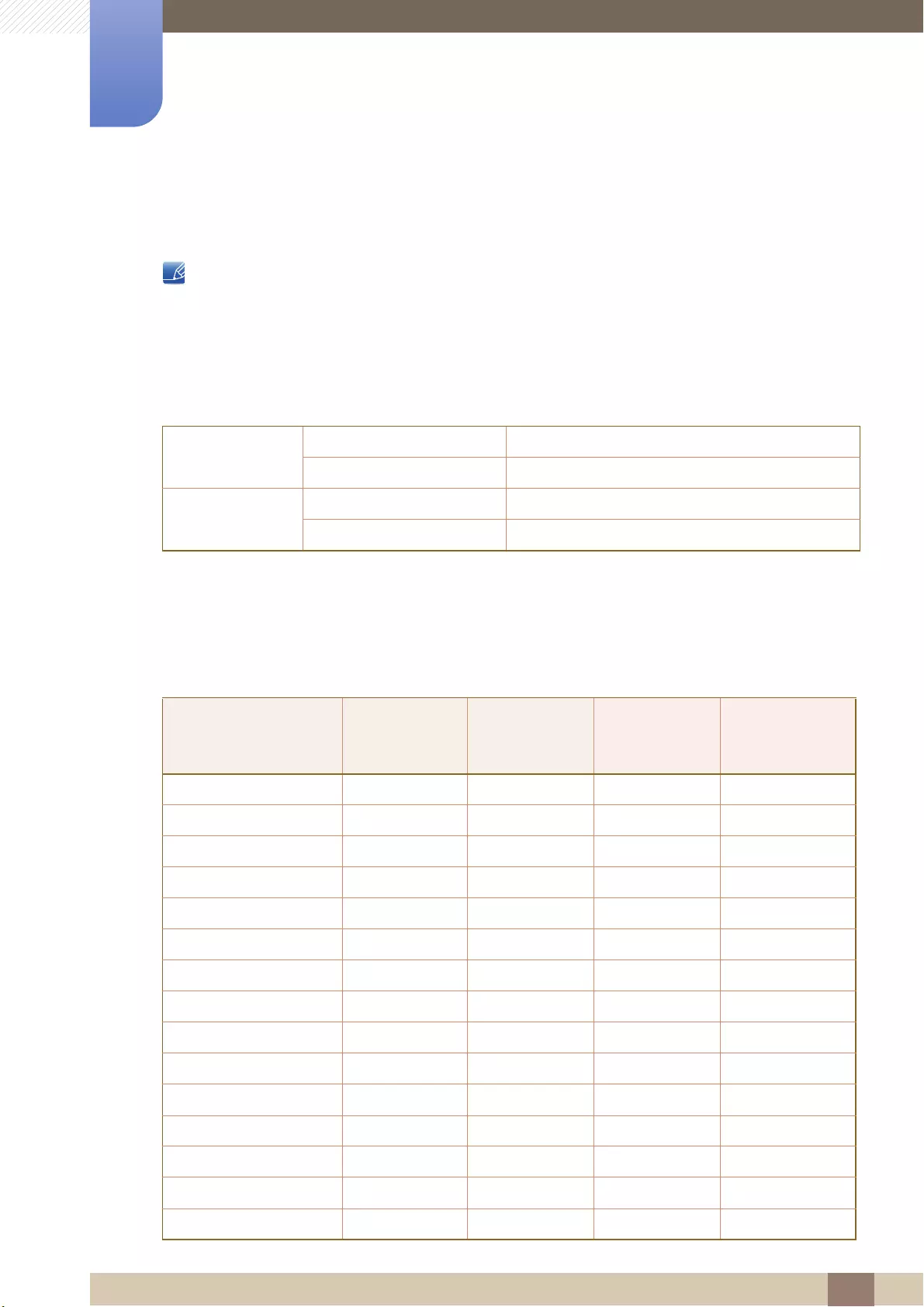
102
Specifications
11
11 Specifications
11.2 Standard Signal Mode Table
This product can be set to only one resolution for each screen size to obtain the optimum picture
quality due to the nature of the panel. Therefore, a resolution other than the specified resolution
may degrade the picture quality. To avoid this, it is recommended that you select the optimum
resolution specified for the screen size of your product.
Check the frequency when you exchange a CDT monitor (connected to a PC) for an LCD monitor.
If the LCD monitor does not support 85Hz, change the vertical frequency to 60Hz using the CDT
monitor before you exchange it with the LCD monitor.
If a signal that belongs to the following standard signal modes is transmitted from your PC, the screen will
automatically be adjusted. If the signal transmitted from the PC does not belong to the standard signal
modes, the screen may be blank even though the power LED turns on. In such a case, change the
settings according to the following table by referring to the graphics card user manual.
Synchronization
Horizontal Frequency 31 – 80 kHz
Vertical Frequency 56 – 75 Hz
Resolution
Optimum Resolution 1920 x 1080 @ 60 Hz
Maximum Resolution 1920 x 1080 @ 60 Hz
Resolution
Horizontal
Frequency
(kHz)
Vertical
Frequency
(Hz)
Pixel Clock
(MHz)
Sync Polarity
(H/V)
MAC,640 x 480 35.000 66.667 30.240 -/-
VESA,640 x 480 31.469 59.940 25.175 -/-
VESA,640 x 480 37.861 72.809 31.500 -/-
VESA,640 x 480 37.500 75.000 31.500 -/-
IBM,720 x 400 31.469 70.087 28.322 -/+
VESA,800 x 600 35.156 56.250 36.000 +/+
VESA,800 x 600 37.879 60.317 40.000 +/+
VESA,800 x 600 48.077 72.188 50.000 +/+
VESA,800 x 600 46.875 75.000 49.500 +/+
MAC,832 x 624 49.726 74.551 57.284 -/-
VESA,1024 x 768 48.363 60.004 65.000 -/-
VESA,1024 x 768 56.476 70.069 75.000 -/-
VESA,1024 x 768 60.023 75.029 78.750 +/+
VESA,1152 x 864 67.500 75.000 108.000 +/+
MAC,1152 x 870 68.681 75.062 100.000 -/-

103
Specifications
11
11 Specifications
Horizontal Frequency
The time required to scan a single line from the left to the right side of the screen is called a
horizontal cycle. The reciprocal number of a horizontal cycle is called horizontal frequency.
Horizontal frequency is measured in kHz.
Vertical Frequency
Repeating the same picture dozens of times per second allows you to view natural pictures. The
repeat frequency is called "vertical frequency" or "refresh rate" and is indicated in Hz.
VESA, 1280 x 720 45.000 60.000 74.250 +/+
VESA, 1280 x 800 49.702 59.810 83.500 -/+
VESA,1280 x 1024 63.981 60.020 108.000 +/+
VESA,1280 x 1024 79.976 75.025 135.000 +/+
VESA,1440 x 900 55.935 59.887 106.500 -/+
VESA,1600 x 900 RB 60.000 60.000 108.000 +/+
VESA,1680 x 1050 65.290 59.954 146.250 -/+
VESA,1920 x 1080 67.500 60.000 148.500 +/+
Resolution
Horizontal
Frequency
(kHz)
Vertical
Frequency
(Hz)
Pixel Clock
(MHz)
Sync Polarity
(H/V)

104
Appendix
Appendix
Contact SAMSUNG WORLD WIDE
Web site: http://www.samsung.com
If you have any questions or comments relating to Samsung products, please contact the SAMSUNG
customer care center.
NORTH AMERICA
U.S.A 1-800-SAMSUNG (726-7864)
CANADA 1-800-SAMSUNG (726-7864)
LATIN AMERICA
ARGENTINE 0800-555-SAMSUNG
(0800-555-7267)
BOLIVIA 800-10-7260
BRAZIL 0800-124-421 (Demais cidades e regiões)
4004-0000 (Capitais e grandes centros)
CHILE 800-SAMSUNG (726-7864)
COLOMBIA Bogotá 600 12 72
Gratis desde cualquier parte del país 01 8000 112 112 ó desde su celular
#SAM(726)
COSTA RICA 0-800-507-7267
00-800-1-SAMSUNG (726-7864)
DOMINICAN REPUBLIC 1-800-751-2676
ECUADOR 1-800-10-7267
1-800-SAMSUNG (72-6786)
EL SALVADOR 800-6225
800-0726-7864
GUATEMALA 1-800-299-0013
1-800-299-0033
HONDURAS 800-2791-9267
800-2791-9111
JAMAICA 1-800-234-7267
1-800-SAMSUNG (726-7864)
MEXICO 01-800-SAMSUNG (726-7864)
NICARAGUA 001-800-5077267

105
Appendix
Appendix
PANAMA 800-7267
800-0101
PARAGUAY 009-800-542-0001
PERU 0800-777-08
PUERTO RICO 1-800-682-3180
TRINIDAD & TOBAGO 1-800-SAMSUNG (726-7864)
URUGUAY 000-405-437-33
VENEZUELA 0-800-SAMSUNG (726-7864)
EUROPE
AUSTRIA 0800-SAMSUNG (0800-7267864)
BELGIUM 02-201-24-18
BOSNIA 055 233 999
BULGARIA
CROATIA 072 726 786
CYPRUS 8009 4000 only from landline, toll free
CZECH 800 - SAMSUNG
(800-726786)
Samsung Electronics Czech and Slovak, s.r.o. V Parku 2343/24, 148 00 -
Praha 4
DENMARK 70 70 19 70
EIRE 0818 717100
ESTONIA 800-7267
FINLAND 030-6227 515
FRANCE 01 48 63 00 00
GERMANY 0180 6 SAMSUNG bzw.
0180 6 7267864*
(*0,20 €/Anruf aus dem dt. Festnetz, aus dem Mobilfunk max. 0,60 €/
Anruf)
GREECE 80111-SAMSUNG (80111 726 7864) only from land line
(+30) 210 6897691 from mobile and land line
HUNGARY 0680SAMSUNG (0680-726-786)
0680PREMIUM (0680-773-648)
ITALIA 800-SAMSUNG (800.7267864)
LATIN AMERICA
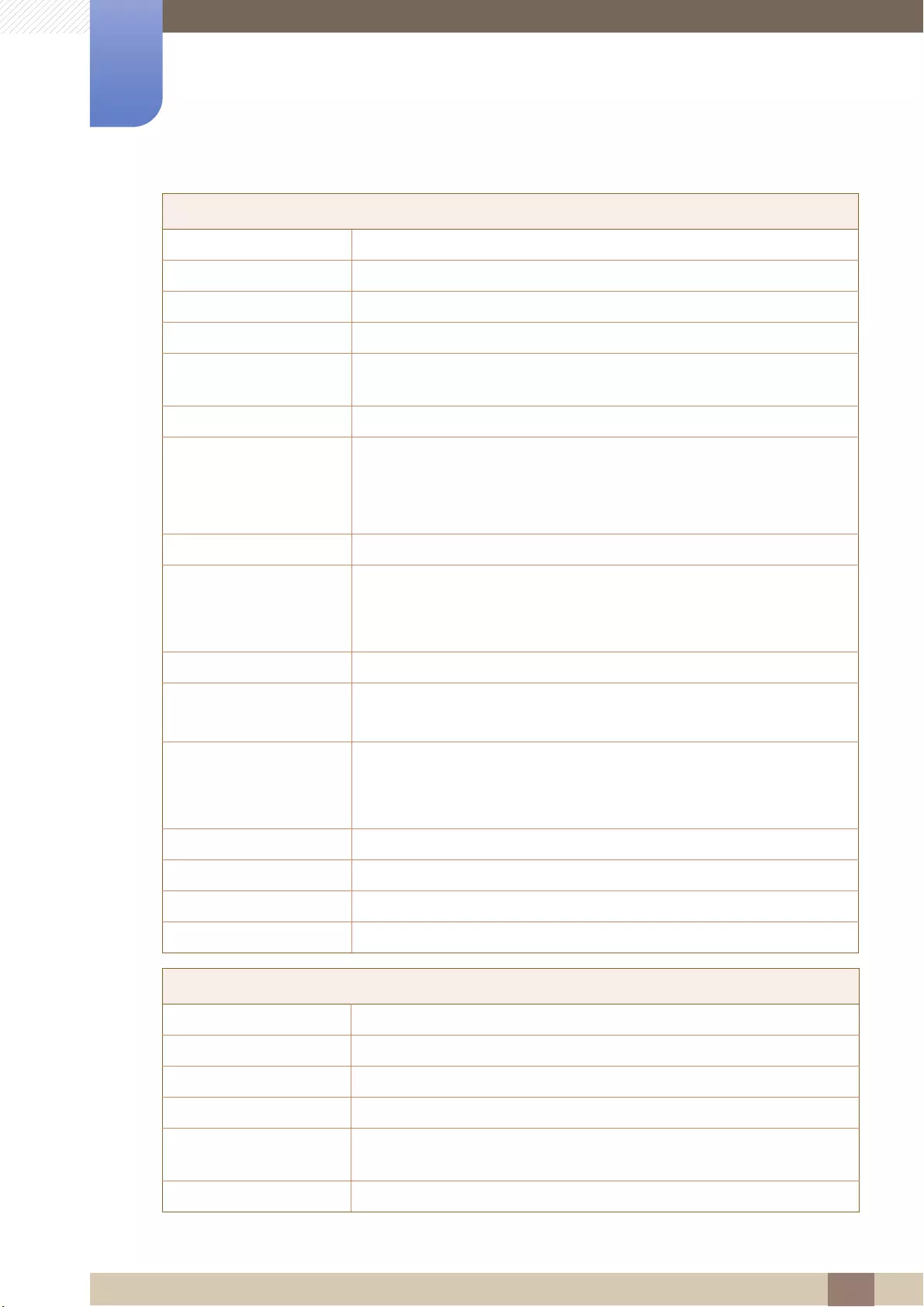
106
Appendix
Appendix
LATVIA 8000-7267
LITHUANIA 8-800-77777
LUXEMBURG 261 03 710
MONTENEGRO 020 405 888
NETHERLANDS 0900-SAMSUNG
(0900-7267864) (€ 0,10/Min)
NORWAY 815 56480
POLAND
PORTUGAL 808 20 7267
ROMANIA 08008 726 78 64
(08008 SAMSUNG)
Apel GRATUIT
SERBIA 011 321 6899
SLOVAKIA 0800 - SAMSUNG
(0800-726 786)
SLOVENIA 080 697 267 (brezplačna številka)
090 726 786 (0,39 EUR/min)
klicni center vam je na voljo od ponedeljka do petka od 9. do 18. ure.
SPAIN 0034902172678
SWEDEN 0771 726 7864 (0771-SAMSUNG)
SWITZERLAND 0800 726 78 64 (0800-SAMSUNG)
UK 0330 SAMSUNG (7267864)
CIS
ARMENIA 0-800-05-555
AZERBAIJAN 0-88-555-55-55
BELARUS 810-800-500-55-500
GEORGIA 0-800-555-555
KAZAKHSTAN 8-10-800-500-55-500
(GSM: 7799, VIP care 7700)
KYRGYZSTAN 00-800-500-55-500
EUROPE
801-172-678*
lub +48 22 607-93-33 *
!"#$%',
#/;<;/#/#=

107
Appendix
Appendix
MOLDOVA 0-800-614-40
MONGOLIA +7-495-363-17-00
RUSSIA 8-800-555-55-55
(VIP care 8-800-555-55-88)
TAJIKISTAN 8-10-800-500-55-500
UKRAINE 0-800-502-000
UZBEKISTAN 8-10-800-500-55-500
(GSM: 7799)
CHINA
CHINA 400-810-5858
HONG KONG (852) 3698 4698
MACAU 0800 333
S.E.A
AUSTRALIA 1300 362 603
INDONESIA 021-56997777
08001128888
JAPAN 0120-363-905
MALAYSIA 1800-88-9999
603-77137477 (Overseas contact)
MYANMAR +95-01-2399-888
NEW ZEALAND 0800 726 786
PHILIPPINES 1-800-10-7267864 [PLDT]
1-800-8-7267864 [Globe landline and Mobile]
02-4222111 [Other landline]
SINGAPORE 1800-SAMSUNG (726-7864)
TAIWAN 0800-329999
THAILAND 0-2689-3232,
1800-29-3232
VIETNAM 1800 588 889
CIS

108
Appendix
Appendix
S.W.A
BANGLADESH 09612300300
INDIA 1800 3000 8282 - Toll Free
1800 266 8282 - Toll Free
SRI LANKA 94117540540
MENA
ALGERIA 021 36 11 00
BAHRAIN 8000-GSAM (8000-4726)
EGYPT 08000-7267864
16580
IRAN 021-8255 [CE]
JORDAN 0800-22273
06 5777444
KUWAIT 183-CALL (183-2255)
MOROCCO 080 100 22 55
OMAN 800-SAMSUNG (800 - 726 7864)
PAKISTAN 0800-Samsung (72678)
QATAR 800-CALL (800-2255)
SAUDI ARABIA 8002474357
SYRIA 18252273
TUNISIA 80-1000-12
TURKEY 444 77 11
U.A.E 800-SAMSUNG (800 - 726 7864)
AFRICA
BOTSWANA 8007260000
BURUNDI 200
CAMEROON 7095-0077
COTE D’ IVOIRE 8000 0077
DRC 499999
GHANA 0800-10077
0302-200077
KENYA 0800 545 545
MAURITIUS 23052574020

109
Appendix
Appendix
MOZAMBIQUE 847267864 / 827267864
NAMIBIA 08 197 267864
NIGERIA 0800-726-7864
REUNION 262508869
RWANDA 9999
SENEGAL 800-00-0077
SOUTH AFRICA 0860 SAMSUNG (726 7864)
SUDAN 1969
TANZANIA 0800 755 755 / 0685 889 900
UGANDA 0800 300 300
ZAMBIA 0211 350370
AFRICA

110
Appendix
Appendix
Responsibility for the Pay Service (Cost to Customers)
When the service is requested, in spite of in warranty, we may charge you for a visit from a service
technician in the following cases.
Not a product defect
Cleaning of the product, Adjustment, Explanation, Re-installation and etc.
If a service technician gives instructions on how to use product or simply adjusts options without
disassembling product.
If a defect is caused by external environmental factors (Internet, Antenna, Wired Signal, etc.)
If a product is reinstalled or devices are connected additionally after installing the purchased product
for the first time.
If a product is reinstalled to move to a different spot or to move to a different house.
If customer requests instructions on how to use because of another company's product.
If customer requests instructions on how to use the network or another company's program.
If customer requests software installation and setup for the product.
If a service technician removes/cleans dusts or foreign materials inside of the product.
If customer requests an installation additionally after purchasing a product through home-shopping
or online.
A Product damage caused by customer's fault
Product damage caused by customer's mishandling or wrong repair
If a product damage is caused by;
External impact or drop.
Use of supplies or separatly sold product unspecified by Samsung.
Repair from a person besides an engineer of outsourcing service company or partner of Samsung
Electronics Co., Ltd.
Remodeling or repairing the product by customer.
Using it with incorrect voltage or non-authorised electrical connections.
Not following the "cautions" in User Manual.
Others
If product fails by natural disaster. (lightning, fire, earthquake, flood damage, etc)
If consumable components are all used up. (Battery, Toner, Fluorescent lights, Head, Vibrator,
Lamp, Filter, Ribbon, etc.)
If customer requests a service in case the product has no defect, service fee may be charged. So
please read User Manual first.

111
Appendix
Appendix
Correct Disposal
Correct Disposal of This Product (Waste Electrical & Electronic Equipment)
Correct disposal of batteries in this product
(Applicable in countries with separate collection systems)
This marking on the product, accessories or literature indicates that the product and its
electronic accessories (e.g. charger, headset, USB cable) should not be disposed of
with other household waste at the end of their working life. To prevent possible harm to
the environment or human health from uncontrolled waste disposal, please separate
these items from other types of waste and recycle them responsibly to promote the
sustainable reuse of material resources.
Household users should contact either the retailer where they purchased this product,
or their local government office, for details of where and how they can take these items
for environmentally safe recycling.
Business users should contact their supplier and check the terms and conditions of the
purchase contract. This product and its electronic accessories should not be mixed with
other commercial wastes for disposal.
(Applicable in countries with separate collection systems)
This marking on the battery, manual or packaging indicates that the batteries in this
product should not be disposed of with other household waste at the end of their
working life. Where marked, the chemical symbols Hg, Cd or Pb indicate that the
battery contains mercury, cadmium or lead above the reference levels in EC Directive
2006/66. If batteries are not properly disposed of, these substances can cause harm to
human health or the environment.
To protect natural resources and to promote material reuse, please separate batteries
from other types of waste and recycle them through your local, free battery return
system.

112
Appendix
Appendix
Terminology
OSD (On Screen Display)
On screen display (OSD) allows you to customize on-screen settings to optimize the picture quality as
required. You can change the screen brightness, tint, size and many other settings using menus
displayed on the screen.
Coarse
Coarse refers to the frequency of radio wave vibrations per second. A higher frequency transmits a
larger amount of data and is reflected easier. A lower frequency traverses obstacles more easily and
can travel farther, but it transmits a smaller amount of data. The Coarse menu allows you to manually
adjust the frequency to obtain the optimum picture quality. Adjust Coarse referring to Standard Signal
Mode Table (page 102) according to the performance of your product and enjoy improved picture
quality.
Gamma
The Gamma menu adjusts the grey scale that represents middle tones on the screen. Adjusting the
brightness brightens the whole screen, but adjusting Gamma only brightens the medium brightness.
Grey scale
Scale refers to levels of color intensity that show variations of color change from darker areas to
brighter areas on the screen. Changes to the screen brightness are expressed with black and white
variation, and grey scale refers to the medium area between black and white. Changing the grey scale
through Gamma adjustment will change the medium brightness on the screen.
Scanning rate
Scanning rate, or refresh rate, refers to the frequency of screen refreshes. Screen data is transmitted
as it refreshes to display an image, although the refreshing is invisible to the naked eye. The number of
screen refreshes is called scanning rate and is measured in Hz. A scanning rate of 60Hz means that
the screen refreshes 60 times per second. The screen scanning rate depends on the performance of
the graphics cards in your PC and monitor.
Horizontal Frequency
Characters or images displayed on the monitor screen consist of numerous dots (pixels). Pixels are
transmitted in horizontal lines, which are then arranged vertically to create an image. The horizontal
frequency is measured in kHz and represents how many times horizontal lines per second are
transmitted and displayed on the monitor screen. A horizontal frequency of 85 means that the
horizontal lines that make up an image are transmitted 85000 times per second. The horizontal
frequency is indicated in 85kHz.

113
Appendix
Appendix
Vertical Frequency
One image is made of numerous horizontal lines. The vertical frequency is measured in Hz and
represents how many images can be created per second by those horizontal lines. A vertical
frequency of 60 means that an image is transmitted 60 times per second. The vertical frequency is
also called "refresh rate" and affects screen flicker.
Resolution
Resolution is the number of horizontal pixels and vertical pixels that form a screen. It represents the
level of display detail.
A higher resolution displays a greater amount of information on the screen and is suitable for
performing multiple tasks at the same time.
E.g. A resolution of 1920 x 1080 consists of 1920 horizontal pixels (horizontal resolution) and 1080
vertical lines (vertical resolution).
E.g. A resolution of 1920 x 1200 consists of 1920 horizontal pixels (horizontal resolution) and 1,200
vertical lines (vertical resolution).
Plug & Play
The Plug & Play feature allows the automatic exchange of information between a monitor and PC to
produce an optimum display environment.
The monitor uses VESA DDC (international standard) to execute Plug & Play.

Index 114
Index
Symbols
"PCoIP" 32
B
Before Connecting 68
Blue 81
Brightness 72
C
Checking the Contents 18
Cleaning 8
Coarse 76
Color Tone 82
Configuring Volume in the Initial Screen 91
Connect to the host PC using a LAN cable 31
Connecting and Using a PC 69
Connection to Use "PCoIP" 28
Contact SAMSUNG WORLD WIDE 104
Contrast 73
Copyright 7
Correct posture to use the product 17
D
Display Time 88
F
Fine 77
G
Gamma 83
General 100
Green 80
I
INFORMATION 91
Installation 22
L
Language 87
M
Menu Transparency 89
MultiScreen 93
N
Natural Color 92
P
Parts 19
Power Key 90
Q
Q & A 98
R
Red 79
Requirements Before Contacting Samsung
Customer Service Center 95
Reset 86
S
Safety Precautions 10
SAMSUNG MAGIC Bright 75
SAMSUNG MAGIC Color 78
Sharpness 74
Standard Signal Mode Table 102

